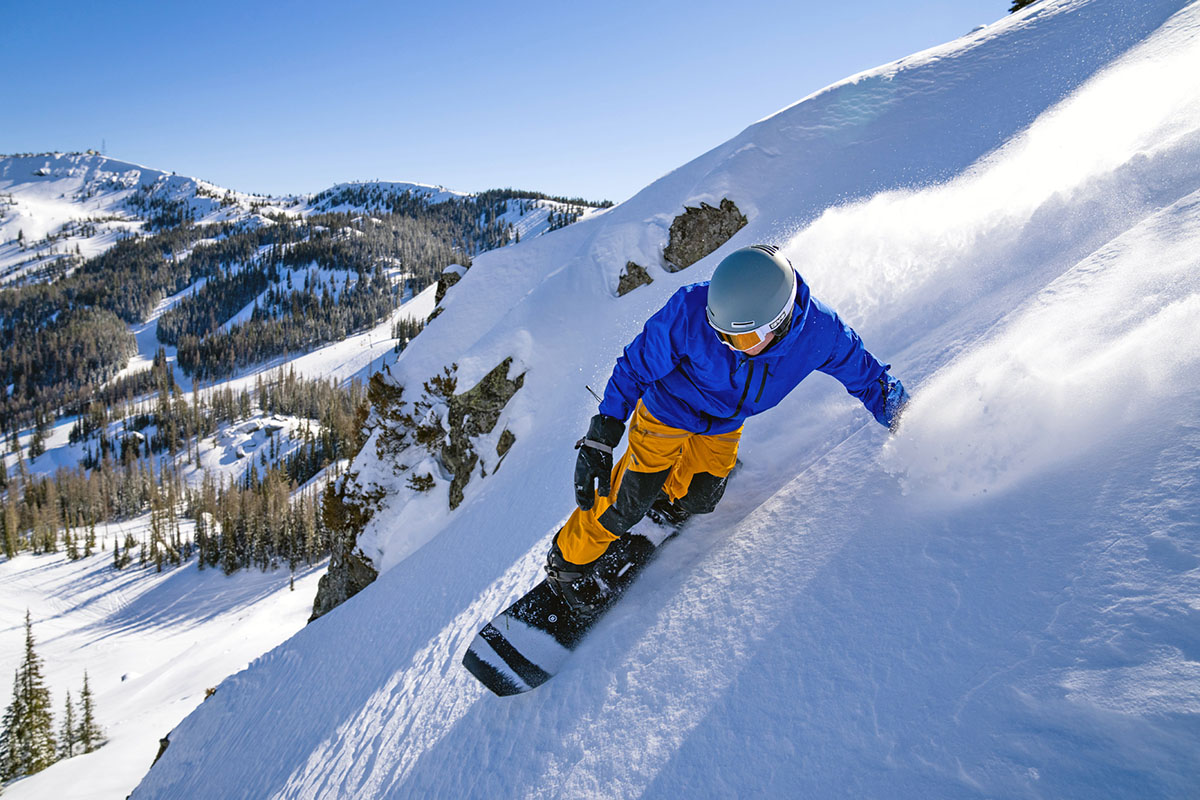
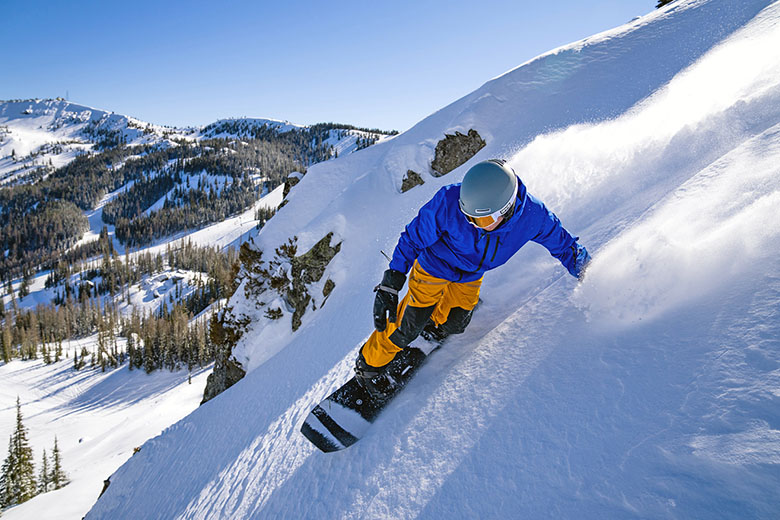
As snowboarding season kicks into high gear, it’s time to take stock of the equipment that will help make your winter that much better. Below we break down the top all-mountain snowboards of the 2024-2025 season, from highly versatile models to those that excel at freestyling in the park or taking on fresh powder. On this list, you’ll find everything from leading budget and beginning options to high-end boards built for experts and hard chargers. For more background information, see our all-mountain snowboard comparison table and buying advice below the picks. And for those who prefer to earn their turns, we've also put together a lineup of the best splitboards.
Editor's note: We updated this guide on November 27, 2024, to move the Burton Instigator Flat Top up as our favorite option for beginners. We also added the Arbor Forumla to the list and included information about our testing practices below the picks.
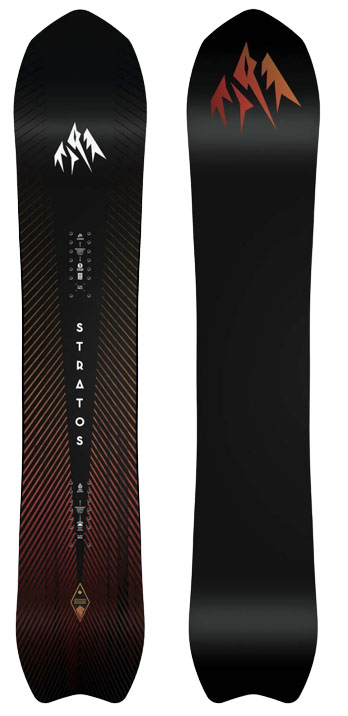 Category: All-mountain
Category: All-mountain
Ability level: Intermediate to expert
Flex: Medium/stiff
Shape: Directional
What we like: A playful yet powerful do-all board.
What we don’t: Too stiff for beginners; not stiff enough for aggressive riders with a need for speed.
If you’re in the market for the quintessential all-mountain board, you’ll be hard-pressed to find a better option than the Jones Stratos. Mixing both freestyle and freeride attributes, the Stratos tackles most terrain and riding styles with aplomb. With a medium-stiff flex, narrow sidecut, and rockered tip, the board has an incredibly playful and poppy personality that’s begging to slash tight trees and bounce off natural or terrain-park features. Tack on a camber underfoot, and you also get an aggressive edge hold when bombing down the mountain at speed. Jones calls the Stratos a “do-it-all turner,” and we couldn’t agree more. For a quiver-of-one board that will get you from the summit to the groomers and through the park with skill and ease, it’s our top pick of the year.
What are the shortcomings of the Jones Stratos? It’s certainly not our first choice for beginners, who will want to learn the basics on a softer, more forgiving board like the Burton Instigator below. On the other hand, most advanced riders will want a stiffer design (like the Jones Flagship Pro) for powering through crud and uneven terrain—the Stratos’ medium-stiff flex means you’ll need a good bit of leg strength to maintain speed on anything other than smooth groomers or pow. Finally, while the board is decidedly playful, its directional tapered shape isn’t ideal for riding switch or tackling most park features. But for one board that can handle a wide variety of all-mountain conditions both front and back, the Jones is an excellent choice.
See the Jones Stratos See the Women's Jones Stratos
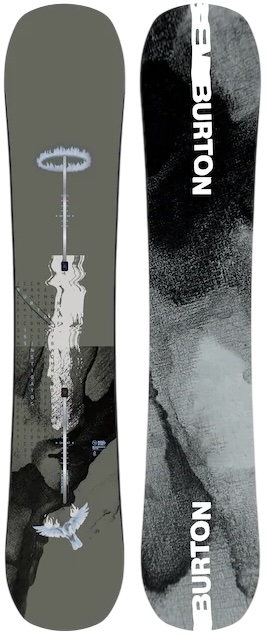 Category: All-mountain
Category: All-mountain
Ability level: Beginner to intermediate
Flex: Soft
Shape: Directional twin
What we like: Easy to maneuver, relatively stable, and won’t disappoint intermediate riders.
What we don’t: Burton's own Ripcord is better for slow learners and will save you some cash.
For beginners, finding a board that balances responsiveness, forgiveness, and affordability is key, and the Burton Instigator Flat Top delivers on all fronts. Its flat profile and rockered tip and tail line up nicely for those learning the ropes: The board isn’t prone to catching an edge and turns in easily even at slow speeds. What’s more, with a forgiving flex that isn’t overly noodly and a directional twin shape, the Instigator is perfectly capable for cruising at a moderate pace on hardpack. And it’s not out of sorts in powder, either. Tack on a reasonable $440 price tag, and the Instigator stands out as a well-rounded option for those looking to gain confidence and refine their skills all over the mountain.
More than anything, the Instigator stands out for its adaptability: It’s plenty maneuverable for those just starting out and will last most riders well into intermediate status. That said, riders who expect a longer learning curve should also consider Burton’s own Ripcord, which features a similar shape and profile but is $20 cheaper and a little easier to maneuver and get on edge. Alternatively, if you’re already a slight step up from beginner (or want to leave even more room to grow), consider Burton’s Instigator Pure Pop Camber, which will be a bit less catchy than the Instigator when carving at high speeds. But again, we think the Instigator puts it all together better than most beginner designs, and we consider the price to be fair for the high level of quality.
See the Burton Instigator Flat Top See the Women's Burton Hideaway
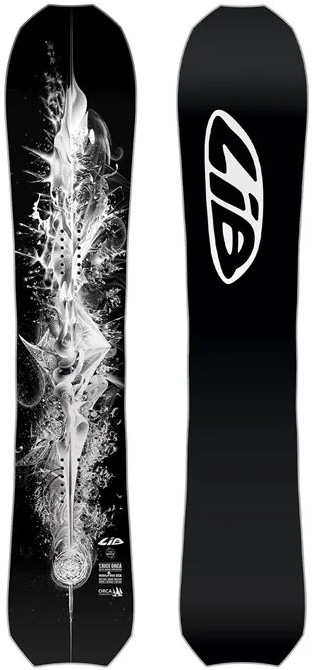 Category: All-mountain/powder
Category: All-mountain/powder
Ability level: Advanced to expert
Flex: Medium/stiff
Shape: Directional
What we like: Super powerful and capable in soft snow.
What we don’t: Not ideal for park rats or new riders.
Many all-mountain boards excel at hardpack and taking on the front side of the mountain, but the Lib Tech T.Rice Orca has a whole different personality. For powerful all-mountain snowboarders who like speed and the deep stuff, it’s one of the top sticks on the market—period. Following the fat and short trend, the volume-shifted Orca features a set-back stance and short radius that allows it to float extremely well, turn on a dime, and dominate in the right conditions. All in all, it’s a terrific board for big-time lines and hard chargers who like to take a straight route down the mountain (or close to it).
Keep in the mind that the Lib Tech T.Rice Orca may be too much board for some riders and uses. The tapered directional shape isn’t ideal for frequent jumps or jibbing in the park, and the stiff flex will take a skilled pilot to tame. And zooming out a bit, the Lib Tech’s volume-shifted design is fairly non-traditional for a big-mountain board—some hard-chargers will prefer to go with a standard directional freeride board like Capita's The Black Snowboard of Death. But for those who like to go fast without compromising float in powder, the Orca is one of the most sought-after boards of the 2024-2025 season.
See the Lib Tech T.Rice Orca
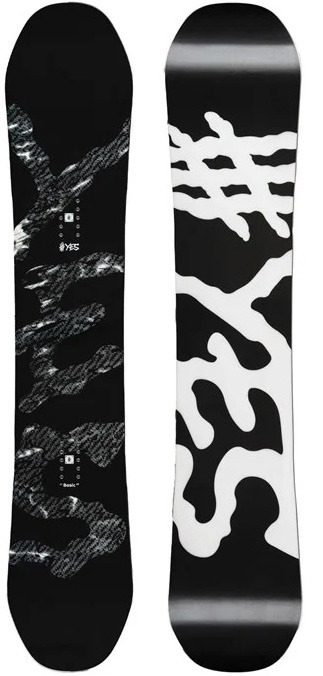 Category: All-mountain/freestyle
Category: All-mountain/freestyle
Ability level: Beginner to advanced
Flex: Soft/medium
Shape: True twin
What we like: Very fun at the park yet still can tackle some tough snow/ice conditions.
What we don’t: Can get chattery and unstable at speed.
If you’re looking for an inexpensive board for ripping groomers and the park, the Yes. Basic is a great option. With a CamRock profile (rocker in the tip and tail and camber underfoot) and medium flex, the Basic is fun, trustworthy, edges and butters extremely well, and can handle hardpack and even ice with relative ease. The true twin shape means that this board really excels in the park and should satisfy even advanced riders there, but its responsiveness works well for the rest of the resort, too. And at $430, the Yes. Basic is one heckuva value.
If there was one big knock on the Basic, it would be that it’s good at a lot of things but perhaps not great at anything. As we mentioned above, it’s totally adept at taking on a variety of all-mountain snow conditions, but it’s not a board that we would frequently want to take up to higher speeds. And while the park performance is really solid overall, there are certainly more purpose-built designs for dedicated park rats, including the Yes. Greats Uninc or Burton Blossom. An asymmetrical twin like the Never Summer Proto Slinger is also a fun option to consider: Its soft flex accommodates a wide range of ability levels, while the shorter heel sidecut adds some playfulness and stability when landing big airs. That said, we really like the Basic’s combination of price and performance, which is why it has remained so popular year after year.
See the Yes. Basic See the Women's Yes. Basic
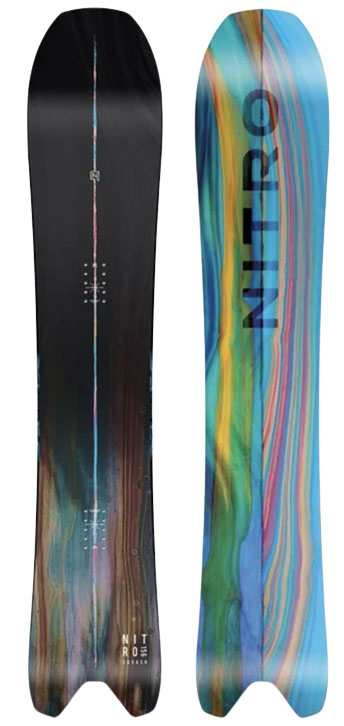 Category: All-mountain/powder
Category: All-mountain/powder
Ability level: Intermediate to advanced
Flex: Medium/stiff
Shape: Directional
What we like: Fun and floaty in powder yet capable in all terrain and conditions.
What we don’t: Some powder enthusiasts will want to have a dedicated powder board in their quiver.
If you live in a high-tide region like the Pacific Northwest or B.C., fresh powder days are a dime a dozen. And while some riders might have a dedicated board for these conditions, there are a number of all-mountain models that also excel in the deep stuff. The Nitro Squash is one of our favorites: Defining Nitro’s “PowGroomer” category, the Squash manages to do it all, from carving through crud to catching air in the park and—of course—floating in the white room.
Like many powder boards, the Squash features a swallowtail with a long shovel nose, ideal for staying on top of deep snow. But under the hood is a more traditional all-mountain design, including a true camber and progressive sidecut that add a lot of edge hold, stability, and snap to your turns. Of course, with its fishtail shape, the Squash isn’t built for riding switch. And while it's a great quiver-of-one board, some deep-snow enthusiasts will want a more niche, surf-inspired design for deep days—we particularly love the Weston Japow and Jones Storm Chaser. But for a powder board that can also hold an edge on hardpack and perform decently well in the park, the Nitro Squash is a great place to start.
See the Nitro Squash
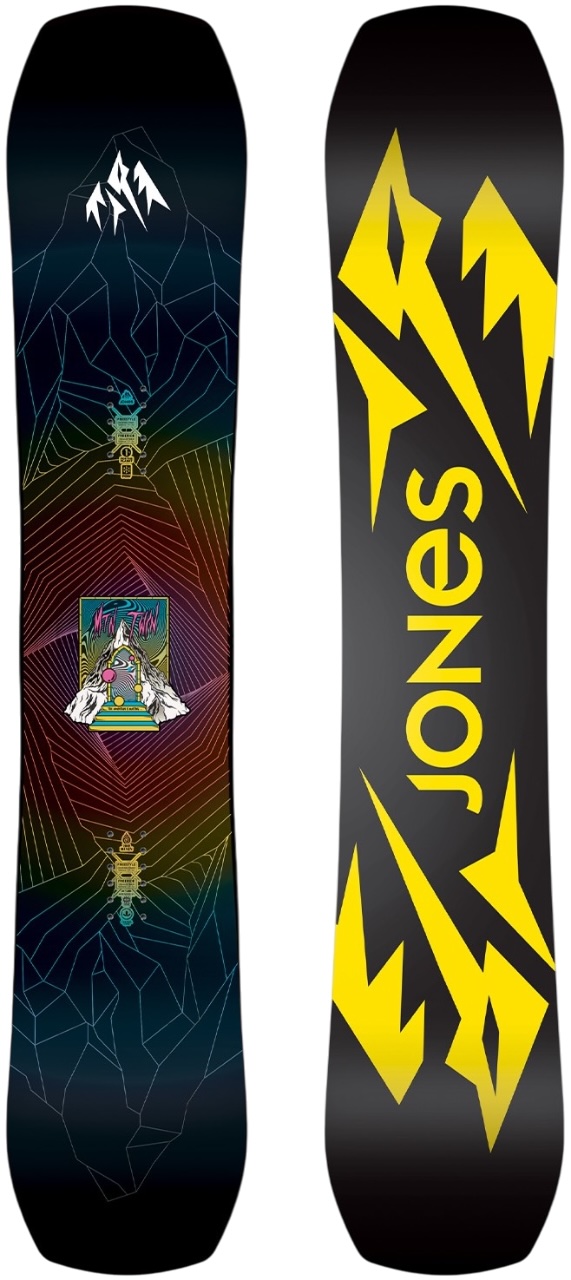 Category: All-mountain/freestyle
Category: All-mountain/freestyle
Ability level: Intermediate to advanced
Flex: Medium
Shape: Directional twin
What we like: Another super versatile board for progressing intermediates.
What we don’t: Hardcore freeriders will want to upgrade to the Mountain Twin Pro.
The Stratos above is arguably the best quiver-of-one board in Jones' lineup, but those who prefer a directional twin shape will love the Mountain Twin. This board has a well-rounded CamRock profile—camber between the feet and rocker at the tip and tail for power and snap—along with Jones' proprietary Traction Tech 2.0 edges for taking on hardpack and ice. The result is an all-mountain ripper that is damp over tough terrain yet can handle sessions at the park. Keep in mind that the medium flex means that it’s not for newbies and is better suited for higher speeds or dabbling with bigger hits.
If this version of the Mountain Twin isn’t enough for you, consider the upgraded Mountain Twin Pro, which is the better match for hardcore freeriders and those with a propensity for speed. Notable differences include the addition of carbon fiber in the base for less weight and more top-end stability, along with a higher price tag of $650. For expert riders who treat the whole mountain like a terrain park, the Mountain Twin Pro is a capable freestyle companion with incredible all-mountain chops. But at the end of the day, the softer, more playful Mountain Twin here is the more versatile option for most recreational shredders.
See the Jones Mountain Twin See the Women’s Jones Twin Sister
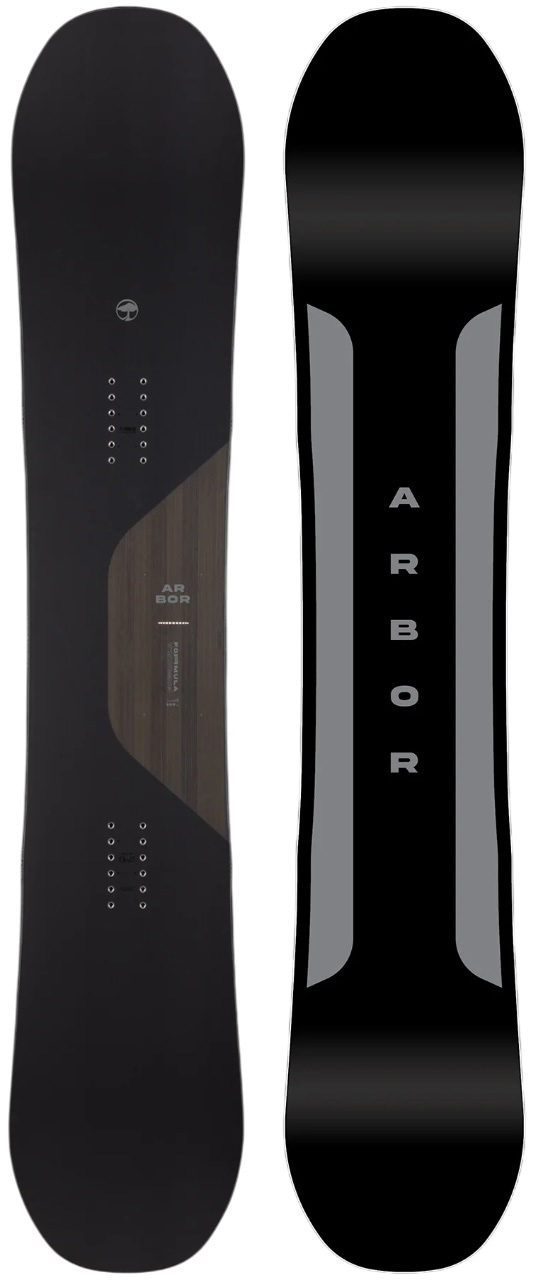 Category: All-mountain
Category: All-mountain
Ability level: Beginner to advanced
Flex: Medium
Shape: Directional twin
What we like: Poppy, fun to ride, and priced right at $400.
What we don’t: Not built for going fast or surfing the pow.
Like the Burton Instigator above, Arbor's Formula board delivers an excellent performance-to-cost ratio. We’ll start off by saying that this snowboard is far from the fastest or surfiest model on this list, but it is one of the most playful and fun. With a directional twin shape, medium flex, and poppy feel, the Formula is designed for those who like to make their way down the mountain in style. If you like to hit the jumps, butter, and jib, the ride here is just about as enjoyable as it gets. Throw in surprisingly good edging and carving abilities and a reasonable $400 price tag, and the Arbor is another solid all-mountain steed.
As we mentioned above, the Arbor Formula’s cambered profile and relatively soft feel lead to disappointing performance at speed, and the board is not meant for effortlessly floating on powder. But it’s nevertheless a nice step up from true beginner models, and the overall design is ideal for beginner-to-intermediate riders progressing to faster speeds and harder charging—especially in dry areas like the East Coast. For $100 more, we also like Arbor's Element, which features a rocker profile for better surf in soft snow at the cost of reduced hardpack performance.
See the Arbor Formula
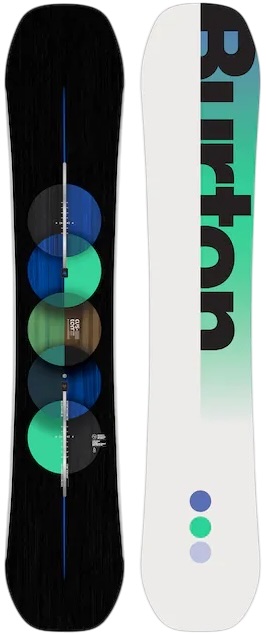 Category: All-mountain
Category: All-mountain
Ability level: Beginner to advanced
Flex: Medium
Shape: Directional twin
What we like: A super versatile board that's both playful and powerful.
What we don’t: Not a great carver.
Burton is one of the biggest names in snowboarding, and the Custom Flying V is arguably their most well-rounded design. First and foremost, the Custom Flying V is easy to ride with a mostly rocker profile (Burton added a zone of camber under each foot, but the board feels more rocker in nature). Add in a medium flex and poppy wood core with a layer of carbon, and you get a responsive and playful ride that’s still powerful when you need it to be. From beginners who want their first board to last to intermediate and even advanced all-mountain riders, the Custom Flying V is a super versatile option.
What are the shortcomings of the Custom Flying V? With a softer feel, it’s more forgiving than many of Burton’s expert-level boards, but it’s not an amazing carver at speed on hardpack and ice. This means that we wouldn’t recommend the Custom for aggressive East Coast riders and hard chargers for whom maintaining a reliable edge is a necessity. It’s also not a true powder hound, although it offers decent float for most resort terrain. But for an approachable, jack-of-all-trades snowboard, there’s a lot to like about Burton’s Custom Flying V.
See the Burton Custom Flying V See the Women's Burton Feelgood Flying V
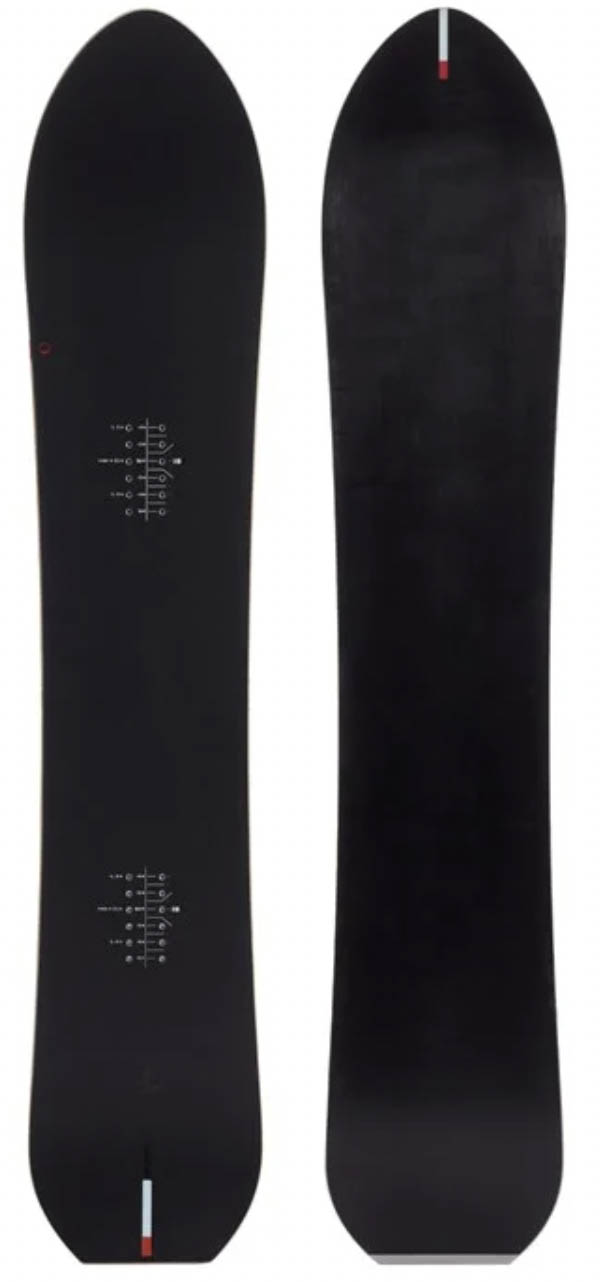 Category: All-mountain
Category: All-mountain
Ability level: Advanced to expert
Flex: Medium/stiff
Shape: Directional
What we like: A versatile and durable board; free annual waxing and tunings.
What we don’t: Some riders won’t love the simply black aesthetic.
A relative newcomer to the snowboard scene, PNW-based Season is already in the business of turning heads. While most manufacturers have large quivers that are updated every couple years—practices that encourage needless consumerism—Season bucks the trend with a sustainability-first, profit-second ethos. Their small lineup includes just five unisex snowboards and one splitboard, most of which feature a fully black topsheet and base (the Primer model has white at either end) that prioritize durability and eliminate the need for an annual freshen-up. And true to their commitment to longevity, all of Season’s products also come with a lifetime maintenance plan through Evo for yearly waxing and tuning.
Season’s offerings are the distillation of decades of riding and product design, each prioritizing versatility so you can get everything you need in one board—not three. The Nexus here is their premium all-mountain model and a capable companion for everything from resort hardpack to sidecountry pow. For a more playful all-mountain design, check out their true-twin Kin. Whichever way you slice it, Season boards are high-performance, expertly built, and offer a strong bang for your buck, especially over time. Finally, keep in mind that you’ll need to live near an Evo store to benefit from the annual maintenance plan—their locations include Denver, Portland, Seattle, Whistler, and Salt Lake City, along with a satellite location at Snoqualmie Pass in Washington.
See the Season Nexus
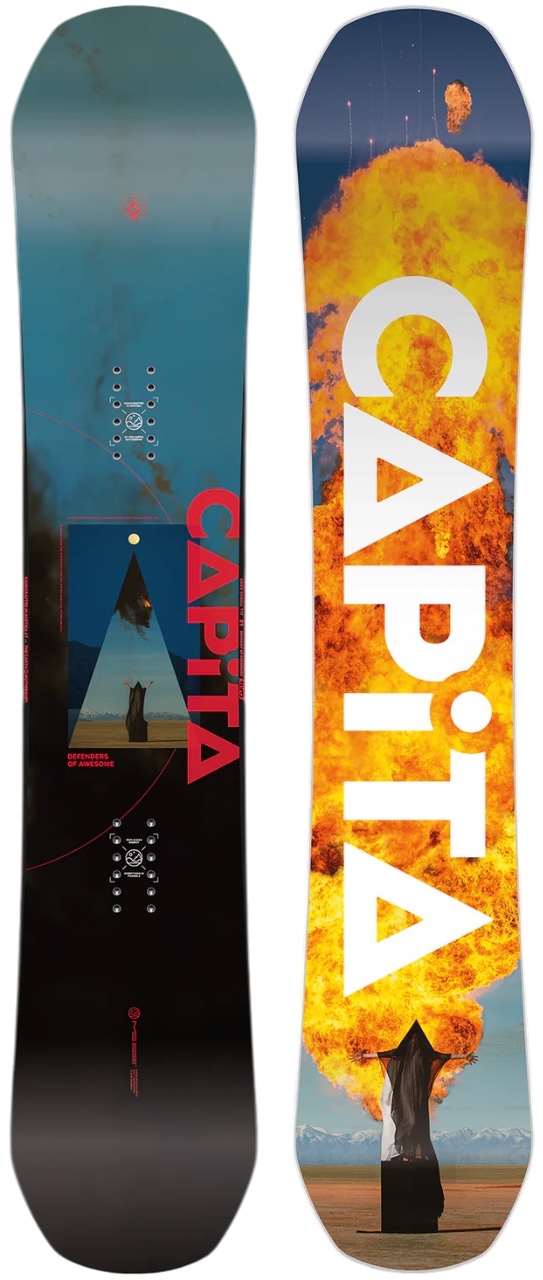 Category: All-mountain/freestyle
Category: All-mountain/freestyle
Ability level: Intermediate to advanced
Flex: Medium
Shape: True twin
What we like: Loves air time.
What we don’t: Doesn’t excel at powder or hitting smaller features.
Racking up awards year after year, the Capita Defenders of Awesome is a super fun freestyle board at a good price. More than anything, you get excellent pop and jumping ability, along with an aggressive ride that experienced riders will really appreciate. With carbon in the build and a super-light poplar and paulownia wood core, it can handle bigger hits and higher speeds than many park boards and is known for being great at sticking the landings. All in all, the Defenders of Awesome is much less about jibbing and buttering than the Lib Tech Skate Banana below, but for serious air, it’s tough to beat.
Despite having a hybrid camber construction that goes camber between the bindings, flat underfoot, and rocker on the tips, the board has a ride that feels more like traditional camber. As a result, it makes you work harder to stay afloat in powder compared with more rocker-heavy designs. Its medium flex is also not ideal for charging hard in variable snow—within Capita's lineup, the Mercury is a better freeride design. But for the all-mountain/freestyle market, the Defenders of Awesome’s power for the price is nearly unmatched, which is why we include it here.
See the Capita Defenders of Awesome See the Women's Capita Birds of a Feather
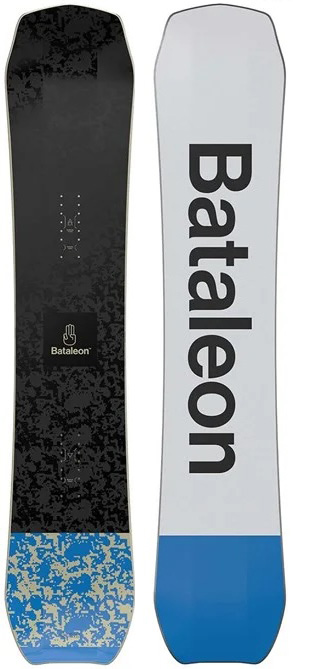 Category: All-mountain/freestyle
Category: All-mountain/freestyle
Ability level: Beginner to advanced
Flex: Medium
Shape: Directional twin
What we like: Directional shape and true-twin contact surface offer a lot of versatility.
What we don’t: Takes some skill to power through crud and bumps.
For those dynamic resort days that warrant a true do-it-all companion, the Bataleon Whatever is an impressively versatile and well-rounded design. As its name suggests, the Bataleon is a suitable ride for whatever you throw at it, whether you’re tossing ollies in the park, slaying pow in the slackcountry, or carving on corduroy. While many boards claim to be capable all-rounders, the Whatever truly embodies it, pairing a directional shape with a true-twin contact surface. Tack on a positive camber and Bataleon’s Triple Base Technology (3BT)—which promotes great carving abilities and pop while still allowing you to stay afloat in the deep stuff—and the result is a medium-flex board that be ridden just about anywhere, by just about anyone.
The Whatever is a great board for the playful rider who likes to jib, butter, and spin their way down the mountain, but it begins to show its weakness when trying to navigate crud at speed. If you like a really powerful and damp board underneath your feet, you’ll likely be better served with a stiffer directional twin like the Beyond Medals version of the Whatever (for a $50 price jump). But for beginner to intermediate shredders looking for a maneuverable ride that doesn’t give up too much performance while bombing groomers or floating through powder, the Bataleon is a skillfully balanced choice.
See the Bataleon Whatever
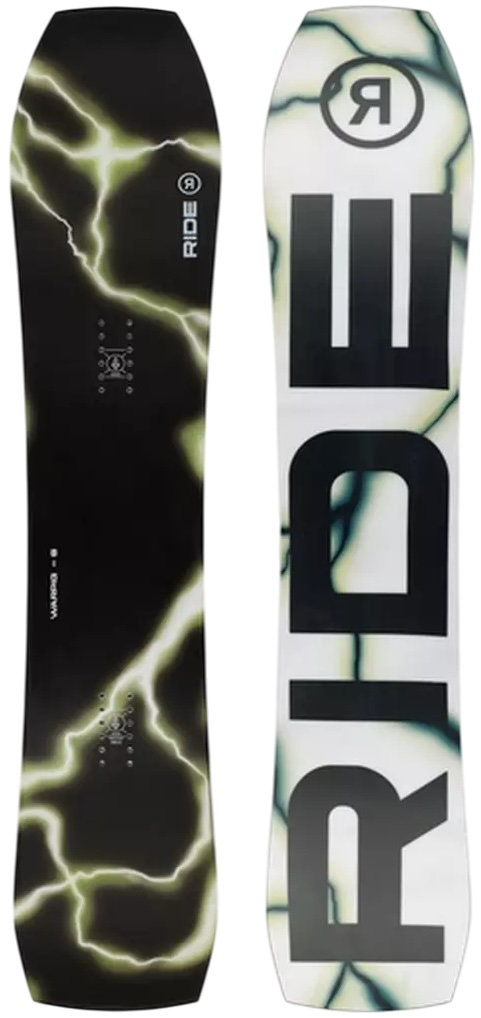 Category: All-mountain/powder
Category: All-mountain/powder
Ability level: Advanced to expert
Flex: Medium
Shape: Directional
What we like: Short and fat can be both surfy and surprisingly agile.
What we don’t: A challenging design for beginning and even intermediate riders.
The Ride Warpig is primed for deep snow, with a short and fat shape (also referred to as “volume shifted”) that’s become very popular of late. The width allows the board to feel both floaty and stable, and the shorter-than-usual length makes it easier to maneuver than you might think. What’s more, it features Ride’s Slim Wall technology, which freshens things up with a lighter weight and better energy transfer between board and snow. Added up, you get a board that’s surprisingly adept at carving and taking on groomers but really excels at surfing the pow. For experienced riders, it’s a viable all-mountain quiver of one (or a super fun backup).
For those who haven’t tried a stout board shape like the Ride Warpig, your intuition might be that you simply need more length to feel comfortable. And traditional design thinking may lean in the same direction, but the numbers are stacking up of satisfied customers who feel that short and wide can be both surfy and good at carving and holding an edge, which is quite a unique combination. If you’re coming from a more traditional board, you might have to adapt your riding style, but who doesn’t love a good learning curve every now and then? All told, the Warpig is a popular and modern option that's certainly worth a look.
See the Ride Warpig
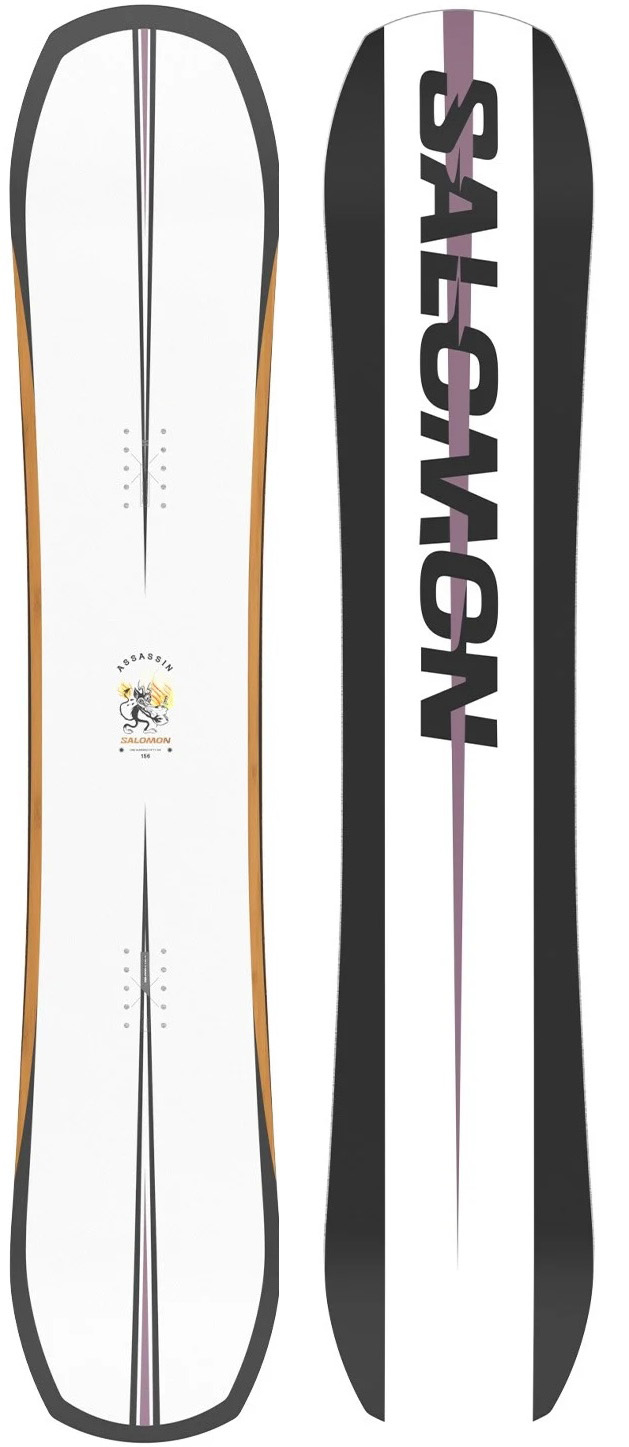 Category: All-mountain/freestyle
Category: All-mountain/freestyle
Ability level: Intermediate to expert
Flex: Medium
Shape: Directional twin
What we like: An all-mountain board that is freestyle/jib-focused.
What we don’t: Center-set stance isn’t great for powder.
Salomon crossed their freeride and freestyle boards to produce the all-mountain Assassin. The result is a playful board that is great for butters, ollies, slashes, switch landings and take-offs—it’s pretty much your good old-fashioned jib-around-the-mountain directional twin. The feel comes from their Rock Out Camber, which is flat between the bindings, camber underfoot, and a bit of rocker under the tip and tail. We think this is a great shape for intermediate and advanced riders: The camber gives the grunt and the rocker allows for good park and light pow play, and the Assassin comes in at a reasonable price point to boot.
Compared to options like the Lib Tech T.Rice Orca and Nitro Squash above, the Salomon Assassin is markedly less of a powder hound. The board is stable, can turn well, and is capable of holding an edge, but you are centered on the board for the most part and less set back than models built more for surfing. On the other hand, the Assassin is quite versatile for taking on a variety of all-mountain terrain, making it a nice option for riders who like both groomers and the park.
See the Salomon Assassin See the Women's Salomon Rumble Fish
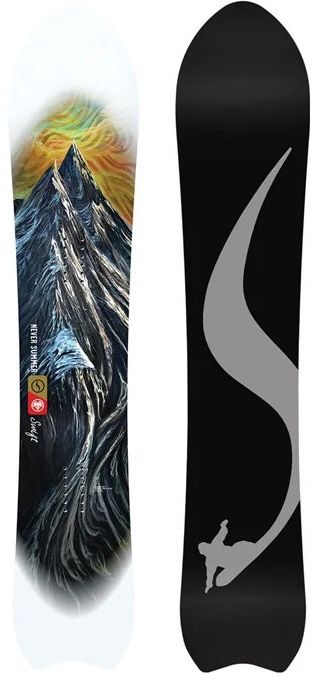 Category: All-mountain/powder
Category: All-mountain/powder
Ability level: Advanced to expert
Flex: Medium/stiff
Shape: Directional
What we like: A powder machine yet surprisingly versatile.
What we don’t: If most of your days are spent on hardpack, there are far better options on this list.
If it wasn’t obvious by the large nose, directional shape, and set-back inserts, the Never Summer Swift is a board that excels in powder. Perhaps even more so than the other all-mountain/powder options included above, the Swift is extremely floaty and borderline dreamy on deep days. In addition, the reverse camber profile helps in initiating turns decently well, which all adds up to a versatile board that doesn’t fit neatly into one box. And to top it off, Never Summer is known for making some of the most durable top sheets in the game, which resist nicking and skillfully shed snow while riding.
Why is the powder-centric Never Summer Swift included on this all-mountain list? The truth is that it transitions surprisingly well to the resort. It’s a good carver for a board of this type and fairly stable across a variety of terrain. For those who live or ride in places like British Columbia, Utah, or Colorado and get a lot of powder days but don’t want to change planks for sessions on mixed snow or hardpack, the Swift is a capable companion.
See the Never Summer Swift
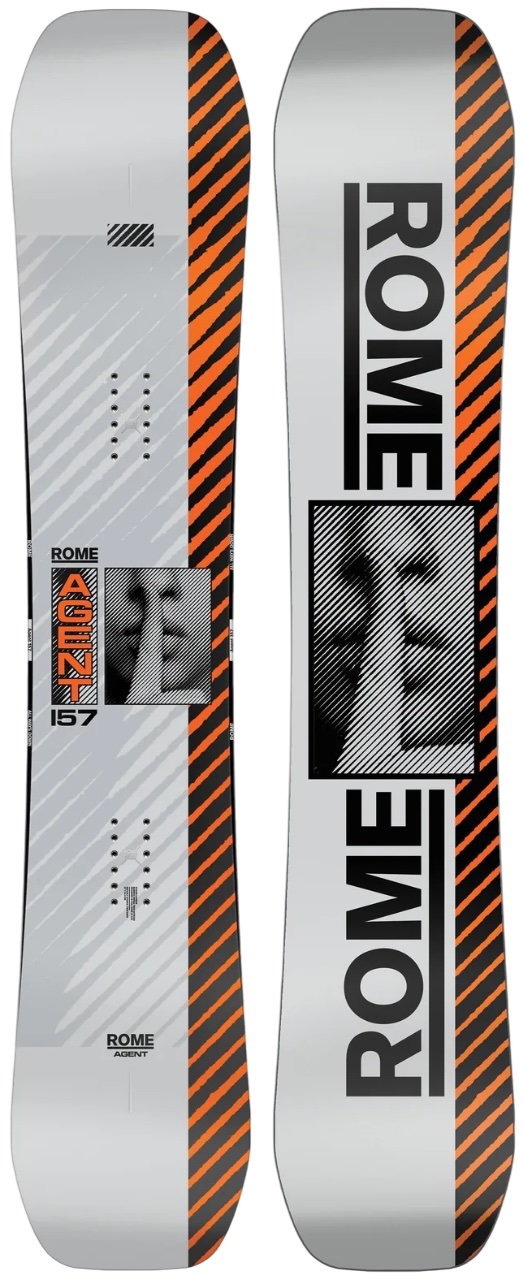 Category: All-mountain/freestyle
Category: All-mountain/freestyle
Ability level: Intermediate to advanced
Flex: Medium
Shape: True twin
What we like: A freestyle board that holds its own in all-mountain terrain.
What we don’t: True twin design isn’t ideal for navigating through powder.
Founded in Waterbury, Vermont, during the early aughts, Rome Snowboard Design Syndicate (aka Rome SDS) offers a wide selection of designs for resort snowboarders. The all-around Agent here is a longstanding staple in their lineup, combining a playful true-twin shape with a fusion camber that progressively stiffens toward the center—in other words, you get pop between your feet and a buttery, relaxed feel at the tip and tail. The result is a board that loves to carve and is impressively stable over chundery terrain but finds its true sense of self while catching airs and jibbing in the park. If you’re hoping to add style to your resort riding or want a freestyle board that can still keep up with your all-mountain friends, the Rome Agent is a great pick.
Looking at the competition, the Agent is most similar to the Whatever above: Both are medium-flex twin boards that beg to ride switch and hang with the park rats. But unlike most freestyle designs, they’re also impressive performers in the pow and on the corduroy. If you’re based in an area that gets consistently deep snow (like the PNW), the Whatever's directional profile makes it a better choice for floating through pow. On the other hand, the Agent features a stiffer construction (thanks to carbon-wrapped bamboo near the nose and tail) that offers more snap on firm snow. Either way you slice it, the Rome Agent is a playful workhorse that makes a great quiver-of-one board, and the price is decent at $500.
See the Rome Agent
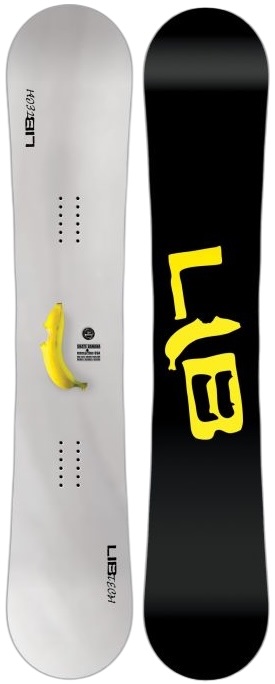 Category: All-mountain/freestyle
Category: All-mountain/freestyle
Ability level: Beginner to advanced
Flex: Soft/medium
Shape: True twin
What we like: A super fun board, especially in the park.
What we don’t: Pretty soft flex; chattery at speed.
The Skate Banana has become a staple of Lib Tech’s snowboard lineup, with a reputation of being a quality stick to learn and progress on. Granted, it’s not the cheapest way to expand your repertoire of tricks and skills, but it has the right build to take you there. The profile is primarily reverse camber—with raised contact points—which makes it less prone to catching an edge on turns, and some minimal camber under the feet adds stability and pop. We also like the Magne-Traction edges that increase hold on hardpacked snow, which is good for shredding groomers or cruising through surprise ice patches. Last but not least, the board comes in a wide range of sizes and widths, meaning that there’s something for just about everyone.
What are the shortcomings of the Lib Tech Skate Banana? It’s one of the softest boards on this list (especially for the price), and at the end of the day, could be categorized more as a park board than an all-mountain ripper. Yes, you can take it down groomers, and particularly at lower speeds, but it’s most at home when buttering, jibbing, and riding switch. But hey, we still think such a legendary and longstanding model deserved to be included in this round-up, and particularly given how forgiving and fun it is all over the hill.
See the Lib Tech Skate Banana BTX See the Women's Lib Tech Glider BTX
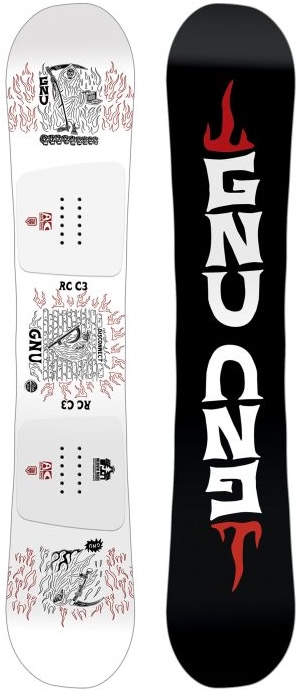 Category: All-mountain/freestyle
Category: All-mountain/freestyle
Ability level: Advanced to expert
Flex: Medium-stiff
Shape: Asymmetrical twin
What we like: Lots of pop and the asymmetrical layout delivers in the bends.
What we don’t: Doesn’t excel in powder and will chatter a bit at high speed.
In addition to the short and wide concept, another growing trend in snowboards is the asymmetrical layout. Simply put, this means the heel side has a more pronounced and shorter sidecut compared with the toe side, which can help with balance and ease of getting your board on edge. Among the various options, the Gnu RC C3 (previously called the Riders Choice Asym C3) stands out in the all-mountain/freestyle market. Its mid-stiff build, mostly camber profile, and Magne-Traction edges combine rock-solid hold when carving with a whole lot of pop and fun in the park. All in all, it’s a very playful board that butters well and encourages you to hit both natural and man-made features.
If you’ve never tried out an asymmetrical board before, there can be a learning curve, but it’s worth the effort if you like a strong turner (particularly on the heel side). Specific to the RC, the main drawback to the design is powder performance, where it lacks the flotation and surf-ability of the more balanced options above. Further, the medium-stiff flex does create some chatter in the tip and tail at high speed. This limited versatility hurts it on our all-mountain-specific list, but the Gnu still is a great groomer and park board to have in your quiver.
See the Gnu RC C3
| Snowboard | Price | Category | Ability Level | Flex | Shape |
|---|---|---|---|---|---|
| Jones Stratos | $630 | All-mountain | Intermediate to expert | Medium/stiff | Directional |
| Burton Instigator Flat Top | $440 | All-mountain | Beginner to intermediate | Soft | Directional twin |
| Lib Tech T.Rice Orca | $700 | All-mountain/powder | Advanced to expert | Medium/stiff | Directional |
| Yes. Basic | $430 | All-mountain/freestyle | Beginner to advanced | Soft/medium | True twin |
| Nitro Squash | $600 | All-mountain/powder | Intermediate to advanced | Medium/stiff | Directional |
| Jones Mountain Twin | $550 | All-mountain/freestyle | Intermediate to advanced | Medium | Directional twin |
| Arbor Formula | $400 | All-mountain | Beginner to advanced | Medium | Directional twin |
| Burton Custom Flying V | $670 | All-mountain | Beginner to advanced | Medium | Directional twin |
| Season Nexus | $550 | All-mountain | Advanced to expert | Medium/stiff | Directional |
| Capita Defenders | $550 | All-mountain/freestyle | Intermediate to advanced | Medium | True twin |
| Bataleon Whatever | $550 | All-mountain/freestyle | Beginner to advanced | Medium | Directional twin |
| Ride Warpig | $550 | All-mountain/powder | Advanced to expert | Medium | Directional |
| Salomon Assassin | $600 | All-mountain/freestyle | Intermediate to expert | Medium | Directional twin |
| Never Summer Swift | $700 | All-mountain/powder | Advanced to expert | Medium/stiff | Directional |
| Rome Agent | $500 | All-mountain/freestyle | Intermediate to advanced | Medium | True twin |
| Lib Tech Skate Banana | $580 | All-mountain/freestyle | Beginner to advanced | Soft/medium | True twin |
| Gnu RC C3 | $700 | All-mountain/freestyle | Advanced to expert | Medium/stiff | Asym twin |
There’s arguably no better way to spend a powder day than on a snowboard, and that’s coming from a team made up of mostly skiers. With that in mind, former senior editor Jenny Abegg was tasked with putting together this guide in 2020, working with avid snowboarder Sam Kapacinskas to choose 15 standouts to showcase. Jenny grew up snowboarding, and while she now spends just as many days on two planks as she does on one, her affinity for the sport—and all the gear required to have a great time—has only grown over time. Editor Maddie Downie took over the guide in 2024. Another snowboarder-turned-skier, Maddie continues to tweak the list based on her extensive experience at resorts throughout Colorado and the Pacific Northwest. To help fill in the gaps, we consult our extensive network of snowboard gear testers, many of whom are featured in the photos scattered throughout our buying advice below.
Our current lineup of 17 all-mountain boards is the product of extensive on-snow testing, insights from trusted contributors, and feedback from friends and the wider snowboard community. When testing snowboards, we typically start by evaluating how characteristics like flex, profile, and shape interact and contribute to a board’s overall performance. We aim to cover as much terrain as possible, carving on hardpack and through crud, venturing off piste, and hitting features in the terrain park to get a good gauge on each board’s strengths and limitations. Since preferred terrain and ability level have a big impact on which board you choose, we make an effort to test a wide variety of designs. Whether you’re a first-timer or an experienced rider, our list above offers a comprehensive look at the entire all-mountain market. And because the space is constantly evolving, we make sure to update our picks regularly, ensuring the guide remains current.
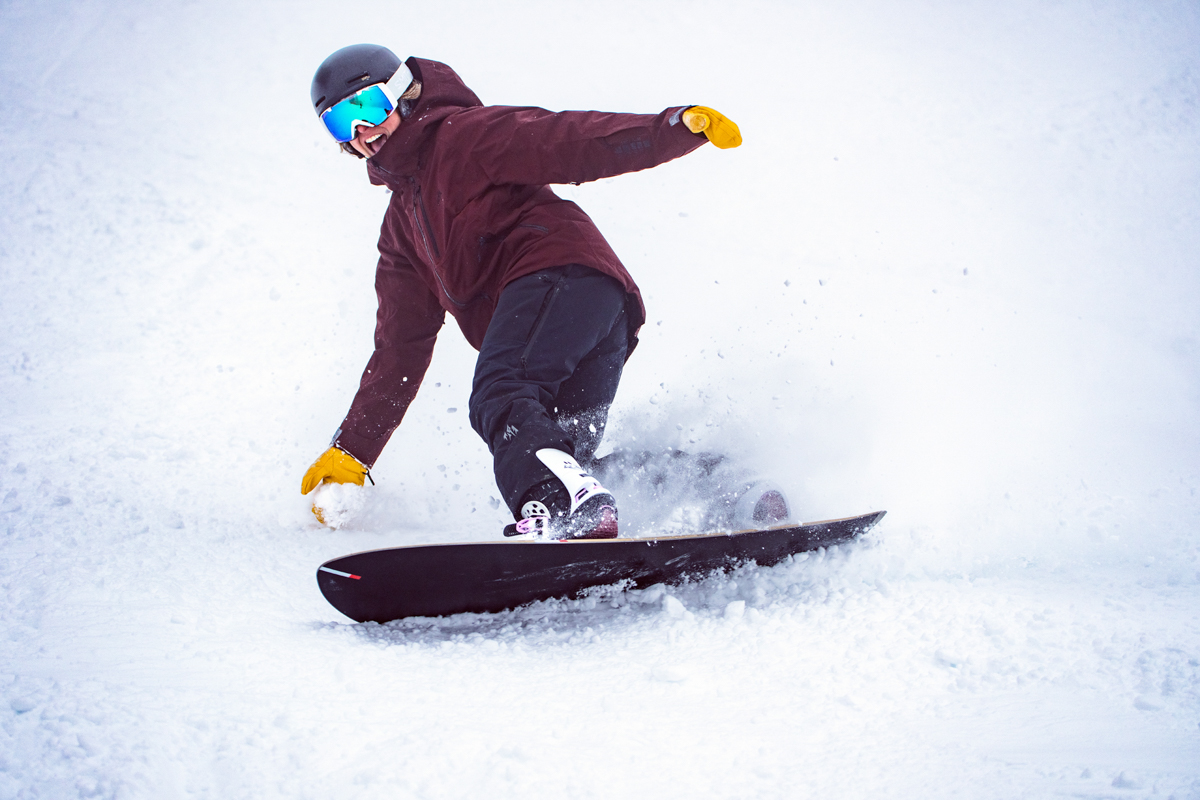
All-Mountain
As their name suggests, all-mountain boards are built to handle any part of the resort, from groomers to the sidecountry, and even a few laps at the terrain park. Common features of this extremely popular category include a medium to stiff flex, extra dampening, and directional or directional twin shape. These planks come up a little short on deep powder days and lack the poppy nature of the freestyle models covered below, but their well-rounded personalities make them the type most riders turn to. Some of our favorite all-mountain designs include the Jones Stratos, Burton Custom Flying V, and Season Nexus.
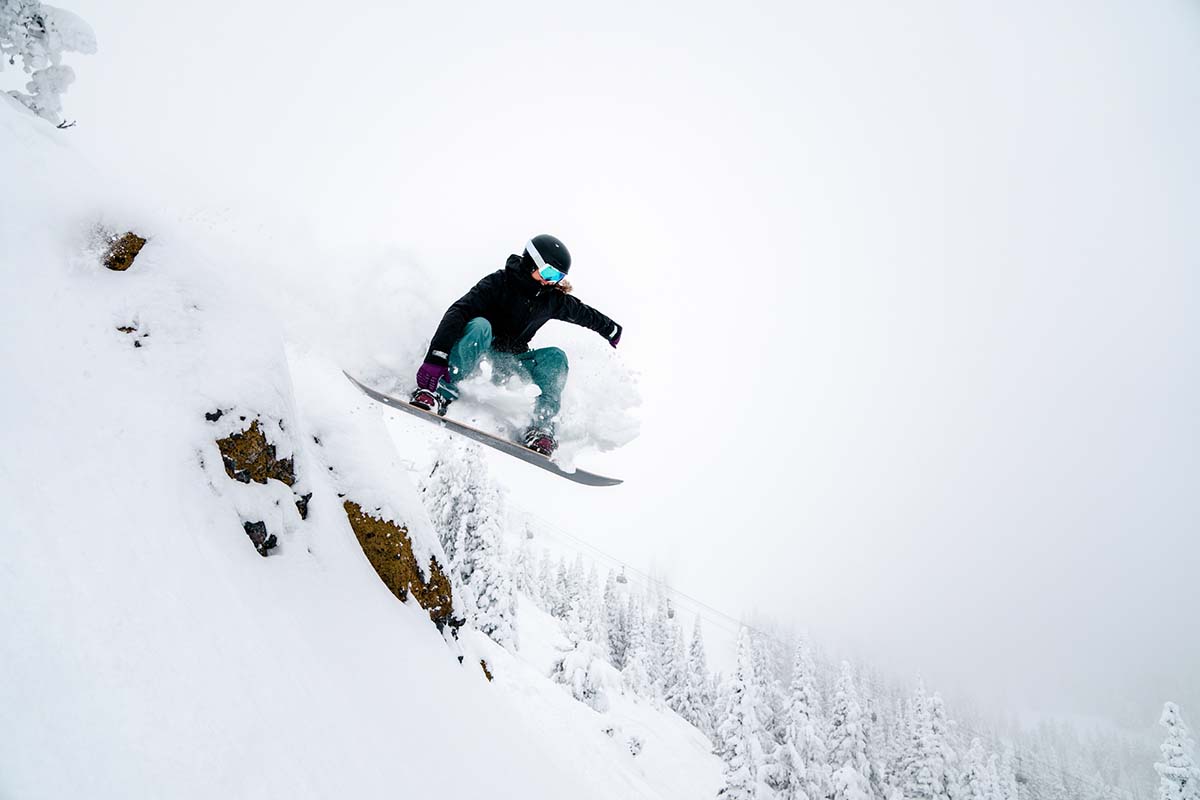
All-Mountain/Freestyle
For hitting features—both natural and manmade—models in the all-mountain/freestyle category shine. These boards’ soft to medium-stiff flex, twin or directional-twin shape, and responsive feel allow you to carve, spin, or gap most terrain you come across. In essence, they combine the versatility of the all-mountain boards described above with the playfulness of dedicated park models. Where they’ll come up short is bombing the mountain at speed due to the flex pattern that prioritizes pop over stability. As a result, options like the Yes. Basic are more prone to chatter than a true all-mountain design but are nevertheless an extremely fun way of spending a day on the hill.
All-Mountain/Powder
For those who frequently board out West and spend a lot of time off trail, fresh snow is common and you’ll want a design with plenty of float. All-mountain/powder boards like the Nitro Squash, Ride Warpig, and Never Summer Swift have characteristics like wide builds, rocker profiles, large noses, and set-back stances that give them a surfy feel in deep snow. Like the freestyle crossover boards above, they do compromise a bit in hardpack and typically aren’t as maneuverable or comfortable in variable snow and ice as a standard all-mountain offering. That said, all-mountain/powder options are still perfectly suitable for keeping you entertained on those light snow days in between storms.
.jpg)
One of the most defining features of a snowboard is its flex, or how much the board bends both longitudinally (along the board’s length) and torsionally (across its width). Most snowboards are either assigned a flex rating on a scale from 1-10 from softest to stiffest or are simply designated as soft, medium, or stiff (and sometimes a mix). It’s important to note, however, that ratings are not standardized across the industry and can vary significantly from one brand or board to another. That said, boards generally fall into one of three categories:
Soft Flex
Starting with soft boards, these are typically tuned for beginners or lightweight riders. Like the Burton Instigator above, they are easier to control and require less muscle to maneuver and turn. In addition, a softer-flexing design excels in the park and for freestyle riding. They’re a lot of fun to press, butter, and maneuver, although this comes at the sacrifice of stability. Hard chargers and those in the intermediate riding level and up will most likely want to steer clear of this flex type. Soft boards are prone to chattering and being overly loose and uncomfortable at speed.
Medium Flex
The sweet spot of the all-mountain category is medium flex: A quality board with this stiffness will provide good stability for railing hardpack or dipping into the trees, while still retaining enough pop for hitting jumps in and out of the park. It does require more energy to handle and turn than a soft board, but the upside is a big increase in all-around performance. All-mountain, powder, and freestyle riders in everything from intermediate to expert ability levels can be happy with a board of this type.
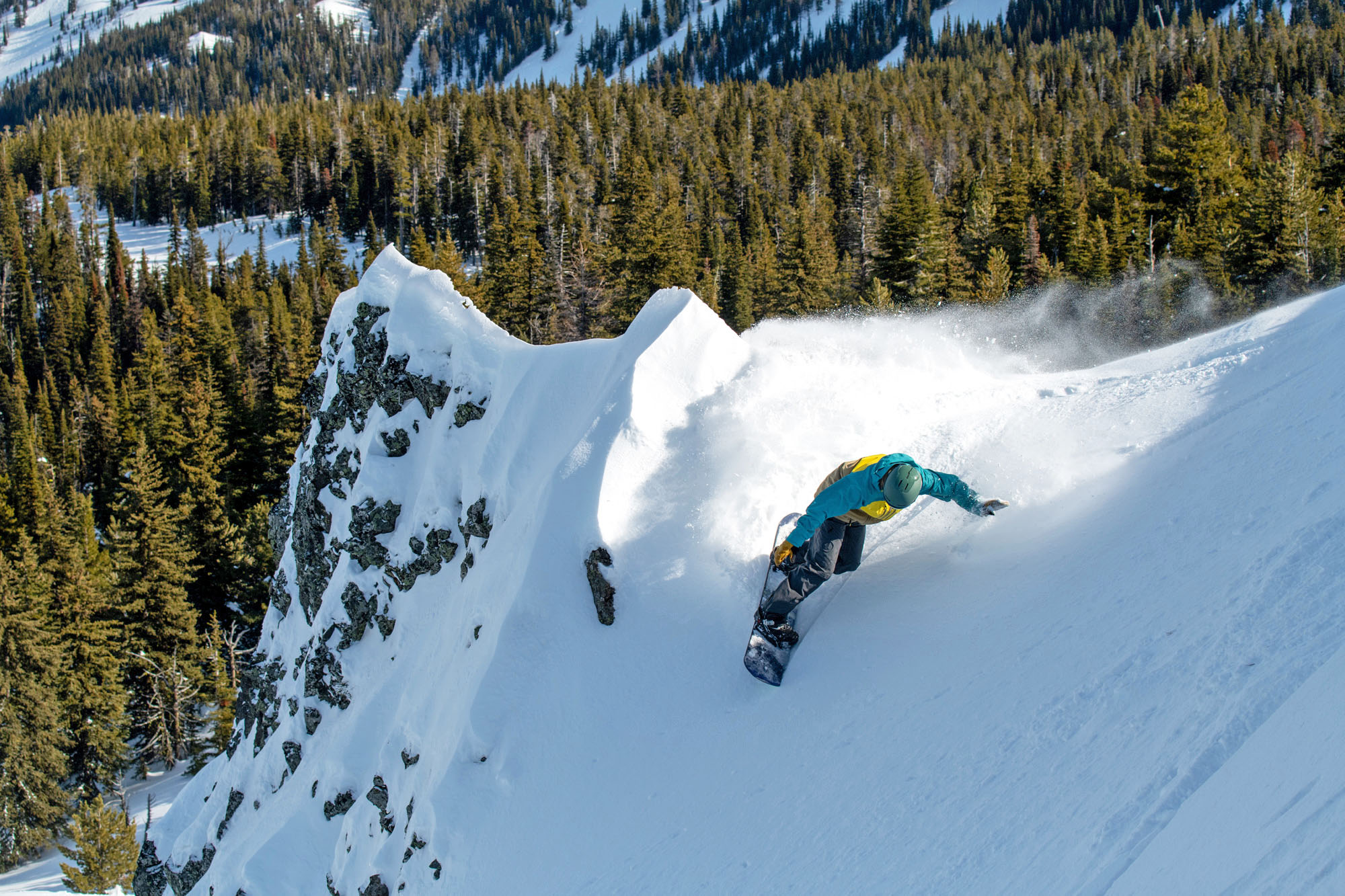
Stiff Flex
The final style is the most serious: stiff-flexing boards. These require a lot of energy to maneuver but hold an edge and are super stable and damp at speed. They don’t get bounced around as much in variable snow and can be trusted hitting big lines. Unsurprisingly, they’re also way too much board for the beginners or even intermediates among us, and really require a capable and confident pilot. But in the right hands, a stiff board like the Lib Tech T.Rice Orca is an absolute crusher.
Another major part of a snowboard’s character comes from its profile, or how the base curves. To get a good visual, just lay a snowboard down flat on a table or bench and take a close look at the side at eye level. All-mountain boards fall into four main types of profiles: camber, rocker (or reverse camber), flat, and hybrid. Each is defined by a different type of riding style, which we break down below.
Camber
A traditional camber profile arches up between the nose and tail, giving the board energy as the base is pressed flat. Because of how they flex, camber boards are responsive, poppy, and can hold an edge through tight or wide curves. However, since the contact points are flexing into the snow, they can also be quite unforgiving if you don’t direct the board with some muscle in variable conditions. In general, you’ll find camber on more jump- and pipe-oriented models, as well as many all-mountain/freestyle and all-mountain boards that aren’t geared toward soft snow. And while some beginner designs also feature camber, the lack of forgiveness means they’re best suited for intermediate to advanced riders who are looking for additional power and stability.
.jpg)
Rocker (Reverse Camber)
Rocker or reverse camber boards are shaped like a banana, with a lifted tip and tail. Rocker boards, like the Never Summer Swift, are generally more forgiving than camber boards due to their resistance to catch an edge and ease of initiating turns, making them a popular choice among beginners. They are also easy to press and butter, which is great for jibbing and hitting smaller features. But perhaps most notably, these boards shine in deep, soft snow (at the sacrifice of liveliness and a strong edge hold). Overall, if you prefer a looser feel or want a board that’s adept at surfing, a rocker profile is a nice match.
Flat
As their name implies, flat profiles feature a primarily flat section at the middle of the board that typically raises at the tips and tails. This shape offers a good deal of versatility: Flat boards maintain some of the poppy nature of camber shapes but will keep you better afloat in powder. To be sure, however, truly flat boards are far from perfect: They’re less responsive and energetic than camber profiles, can be prone to catching edges, and offer less overall maneuverability. Caught a little in between categories, a fully flat board is a pretty rare sight. That said, manufacturers will utilize strategic flat sections to boost performance either in soft snow or at the park.
Hybrid Rocker/Camber
Hybrid boards dominate the all-mountain market and use both rocker and camber in different areas to harness the benefits of the various profiles. Depending on where and how much is used, these boards can have very different personalities. For example, camber between the feet and rocker outside makes a board responsive with the “pop” of a camber profile, but it’s still ultimately catchier than a full-on rocker board. Because of the wide range of designs, hybrids can be found in all three categories of boards depending on the intended terrain. But in general, this profile is good for intermediate to expert riders looking for the most versatility.
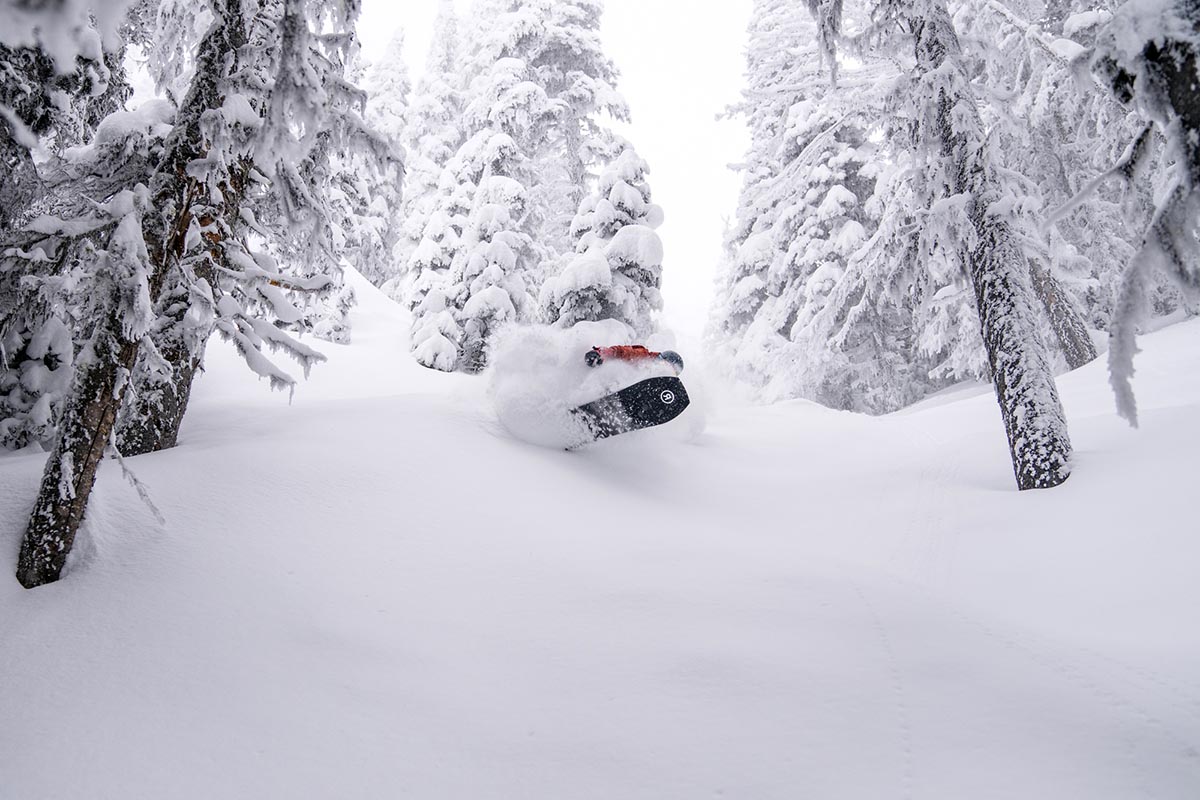
A snowboard’s shape refers to the symmetry of the board between its nose and tail. This dictates where you should take a board and what type(s) of conditions it’s built to handle, so it’s crucial to make sure a board’s shape suits your riding style before buying. As with profile and flex, shape can be broken down into a few key categories: directional, true twin, and directional twin.
Directional
It likely won’t come as a surprise that directional boards are designed to be ridden in one direction. With some set back in the bolts (more than semi-twins covered below), a large damp nose, and a stiff tail, these boards are meant to absorb chatter and provide float in front while offering a solid base in back. Some powder-specific models will also have a cutout tail and a slightly softer flex for a floatier, surfy feel in soft snow, but in general these boards—like the Jones Stratos—are relatively stiff and purpose-built for stability and carving at speed. As such, they are tailored to more aggressive and advanced riders who are looking for a fast all-mountain board.
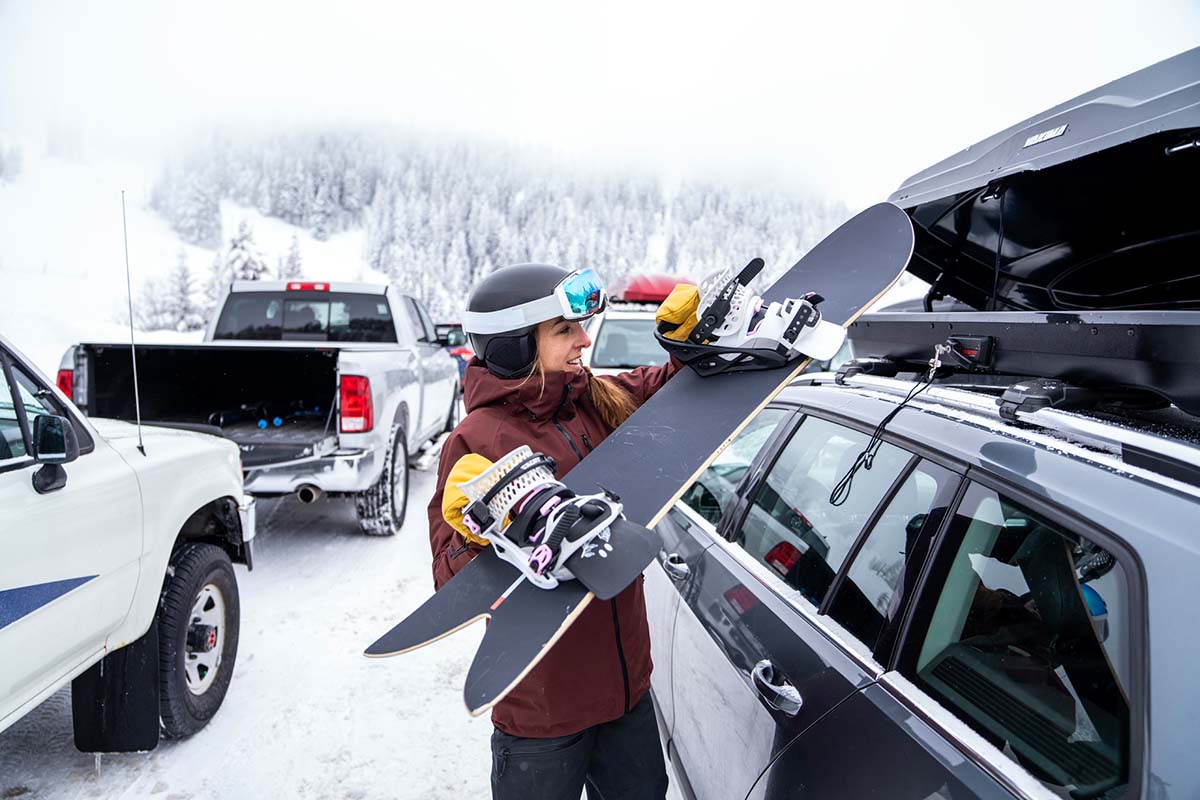
True Twin
True to the name, twin snowboards are symmetrical at the nose and tail. And while they can be found all over the mountain, twins shine in the park and on pipes, as they offer the same performance whether riding forward or switch (with your non-dominant foot in front). In general, they are the least aggressive compared to the other shapes—you can’t put the power down like a board with a directional layout—and are usually only found in park and all-mountain/freestyle designs.
Directional Twin (Semi-Twin)
Combining the two categories above, semi-twin/directional twin boards are almost (but not entirely) symmetrical. They often have a slight set back of the bolts and include moderate differences between the nose and tail. Commonly, the front end on semi-twins is longer, which helps add float in powder or dampen choppy snow. They also excel in the park and for freestyle use as long as you don’t ride or land switch a lot. This well-rounded nature makes directional twins the most common shape type in the all-mountain category. You’ll find it on everything from the all-around Burton Custom Flying V to the jib-ready Salomon Assassin and Jones’ popular Mountain Twin.
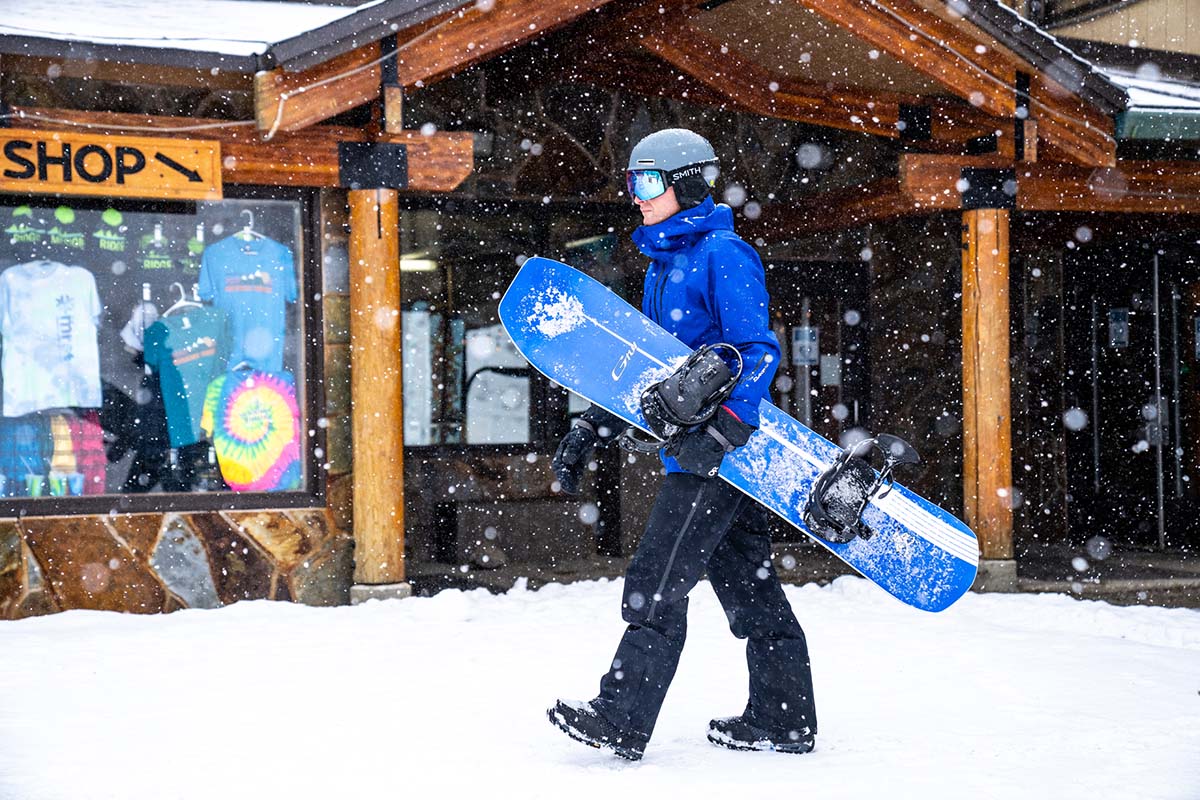
A relatively new board shape that is gaining some momentum is the asymmetrical design. In short, what this means is that the heel side has a sharper and shorter sidecut than the toe side (the vast majority of boards have two identical sidecuts)—we see this in the Gnu RC C3 above. This makes it easier and a bit more natural for some riders to roll into and hold heel-side turns, which can be a benefit to new boarders or those that take pride in precisely carving on groomers or firm snow. Whether or not it’s a worthwhile piece of tech is very much personal preference, but there are some tangible ride differences that some boarders will be happy with. Finally, it’s worth mentioning that most asymmetrical boards are considered “twins,” since the rest of the design is identical front to back. This allows manufacturers to make a single layout for both goofy- and regular-footed riders.
The length of a snowboard doesn’t vary dramatically (we’re talking a difference of 5-10 centimeters within a whole line oftentimes), but finding the right size for your weight and riding style nevertheless is crucial for maximizing performance. In general, aggressive and fast downhill riders will typically want a longer board, while beginners or those who prefer easy maneuverability will want a lighter and shorter option. Manufacturers and retailers will usually provide a recommended size chart for each specific model or model line. But for more general information, we’ve found this article and corresponding video from snowsports retailer Evo to be a helpful resource.
In addition to length, width is equally important to nail down when purchasing a snowboard. When sized correctly, your boots should hang over the edges of the board slightly but should not touch the snow when you get on edge (this can cause your toes to drag and lead to a fall). If you have larger feet, we recommend looking for a wide board, which is often indicated with a “W” right after the length (for example, 154W). Manufacturers often publish helpful info on when to size up to a wide board, which is commonly around a size 11 or 12 for men and 9 for women (and those with very large feet should check out a short and fat board, which we cover below). Finally, women who need a wider model should also consider looking at regular-waisted men’s versions.
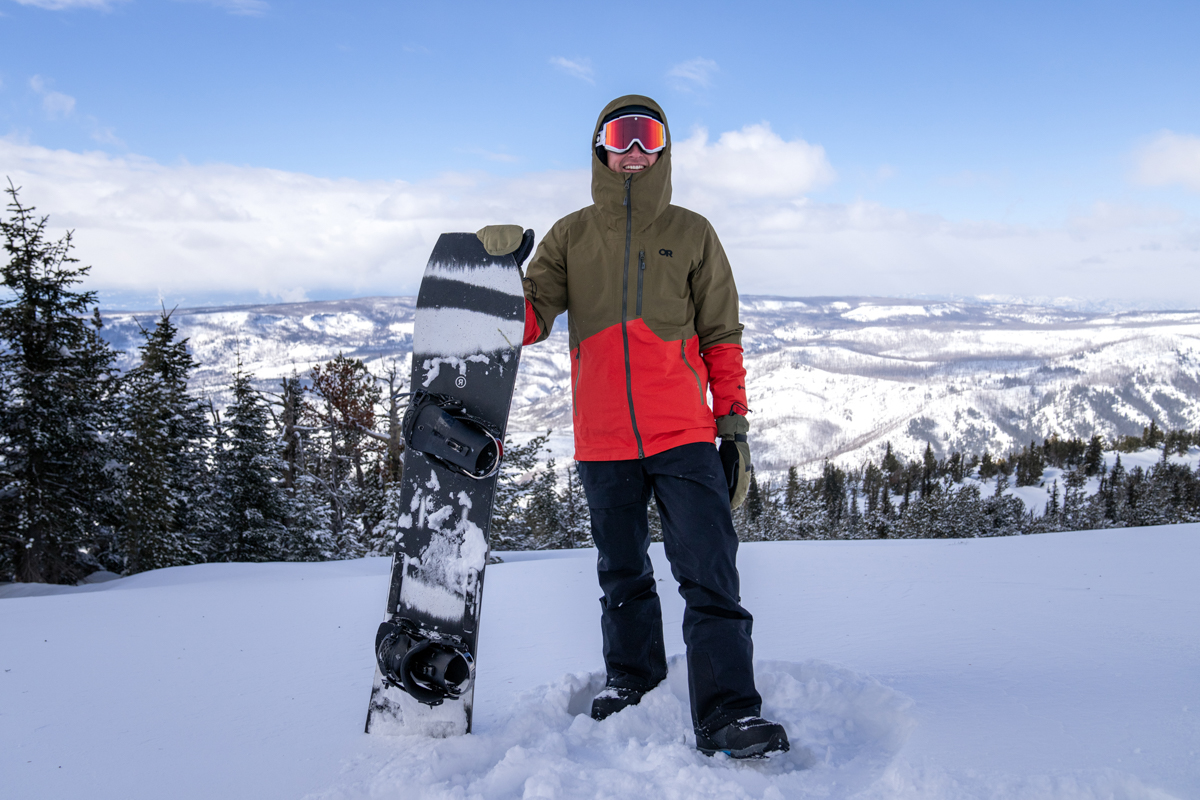
Put simply, sidecut radius is an indication of how tightly or widely a snowboard turns. It’s a measurement of what size circle (usually in meters) would result from the arc created by the board’s edge. Generally, a snowboard with a narrow waist compared to its tip and tail will have a shorter sidecut radius (which equals a narrower turn), while a wide-waisted board will have a longer sidecut radius (which translates to a wider, arcing turn).
We won’t get too deep into the nitty-gritty—sidecut is actually a very nuanced and detailed topic—but there are three important considerations that ultimately affect your ride. First and foremost, sidecut interacts with your board’s flex, profile, shape, and effective edge to make turns wider, narrower, faster, slower, smoother, or more energetic. Second, the sidecut radius on the same board in different sizes will vary, which can be helpful in making a decision if you’re between lengths. Finally, beginners will generally prefer a smaller sidecut, which allows for quicker and more easily initiated turns.
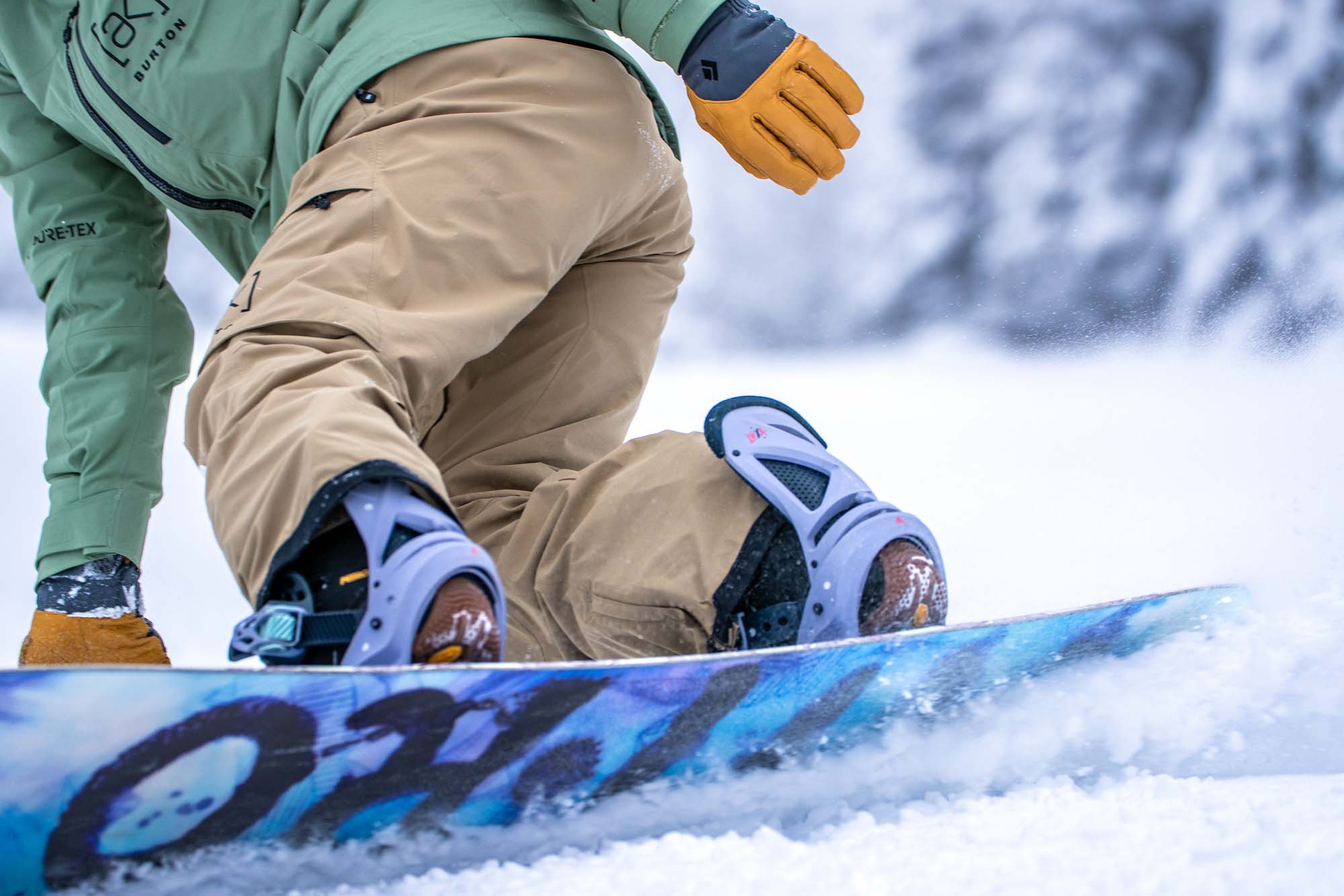
A snowboard’s effective edge (commonly measured in millimeters) is the part that actually touches the snow while the board is on edge. Importantly, this isn’t the actual length of the board or the entire metal edge but only the section that comes into contact with the ground. So what’s the point of checking on this number? The spec can be useful when comparing similar boards: A longer effective edge bites into the ground better, which translates to greater stability and hold through a turn (especially useful in icy conditions or at high speeds). On the other hand, a shorter effective edge is a plus for beginners or freestyle riders as it makes it a bit easier and less catchy to turn and slide. The good news is that this piece of information is commonly listed by the manufacturers. And a final note: Like the sidecut radius, the effective edge obviously changes as you switch between lengths.
.jpg)
Along with flex, profile, and shape, the core is an integral component of a board’s overall character. This is essentially the part that gives each board its unique pop, flex, dampening, durability, and responsiveness. It’s also often where you’ll find the most discernible differences between budget-friendly and high-end models. Most cores are made of wood strips—like poplar, birch, aspen, or bamboo—laid out from nose to tail and edge to edge and pressed into plywood, giving them strength and flex both longitudinally and torsionally. As a general guideline, materials like carbon, basalt, and bamboo are flexy and snappy, while urethane, cork, and Kevlar add extra dampening and are softer to better absorb impacts. All of the boards that made our list for the 2024-2025 season are well made and use quality materials, although as price goes up, the use of premium touches like carbon fiber deliver tangible performance benefits like less weight and more power and stability.
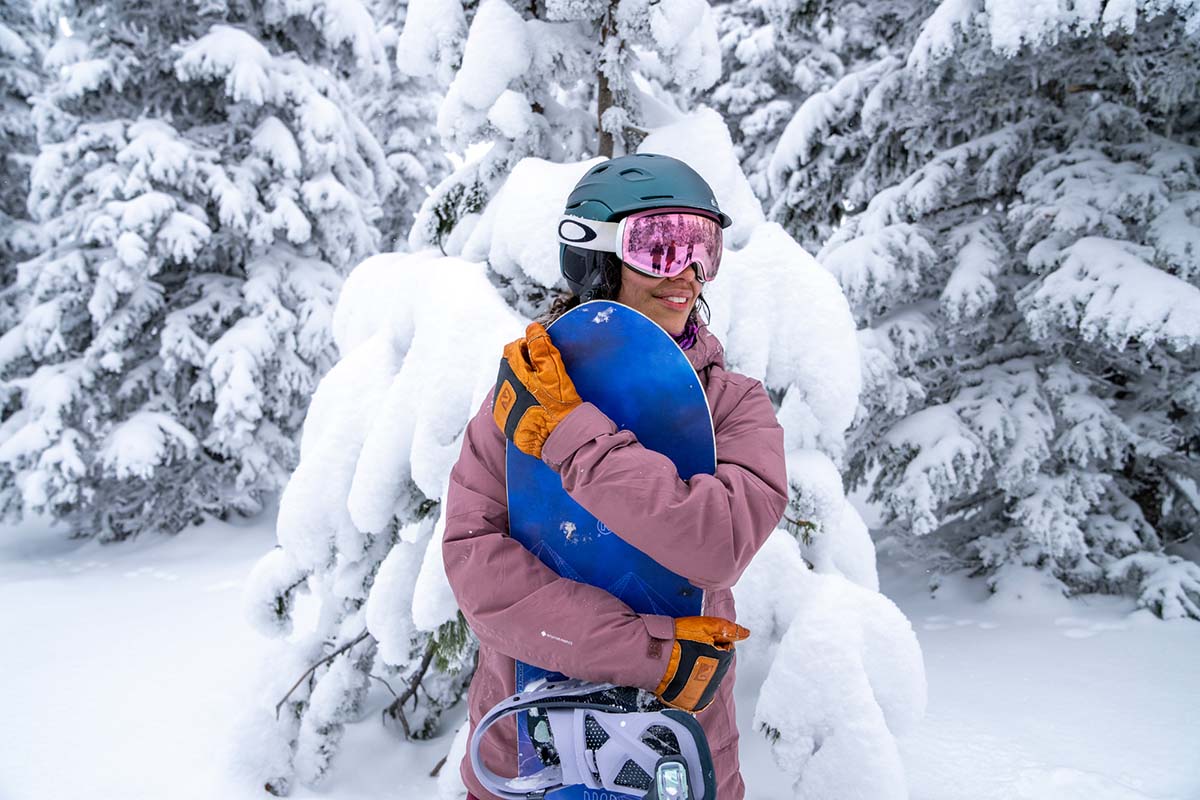
The job of a snowboard’s polyethylene (PE) base is to repel moisture, keep you sliding downhill, and protect the core. There are two types used in snowboard bases: sintered and extruded. Sintered bases are made by compressing small bits of plastic together at a high pressure to create a porous but solid material. Because of these microscopic pores, sintered bases absorb waxes better, making them faster and more adaptable to different snow conditions. Unfortunately, they can be more difficult to repair if damaged by rocks, hard stumps, or rails. Plus, they require more maintenance to keep the wax fresh. That said, most boards—including all-mountain freestyle and all-mountain boards—have sintered bases due to the speed benefits, and are best for intermediate to advanced riders.
.jpg)
Extruded bases, on the other hand, are created by melting polyethylene pellets together, which creates a foundation with very few pores. The main benefits are that they are less expensive, cheaper and simpler to repair, and low-maintenance (they don’t need to be waxed as often). Extruded bases do tend to be slower than their sintered counterparts, but this can be a plus for those who primarily use their board for jibbing and park features. Having a rock board with an extruded base for early-season riding when damage is more likely to occur also makes a lot of sense. Finally, the ease of use is good news for beginners, who typically don’t need the added speed but will benefit from the more basic construction. As an example, Arbor’s value-oriented Formula ($400) uses this type of base.
Also known as volume-shifted boards, these models trim off a surprising amount of length (sometimes 10cm or more) from a standard design while increasing the width. Quality options from the list above include the Lib Tech T.Rice Orca and Ride Warpig. Both boards have excellent stability and float, and the shorter length also helps maneuverability in tight spots. In addition, the extra width makes them a nice match for those with large feet that have issues with their toes hanging off the edges. Downsides are they aren’t going to be as rock-solid as longer boards for wide and fast sweepers, and they can be harder to manage for beginners. In the end, like the asymmetrical trend touched on above, there’s a time and place for short and fat boards—and arguably they offer greater performance benefits—but it does come down to personal preference if it’s the type of ride you’re looking for.
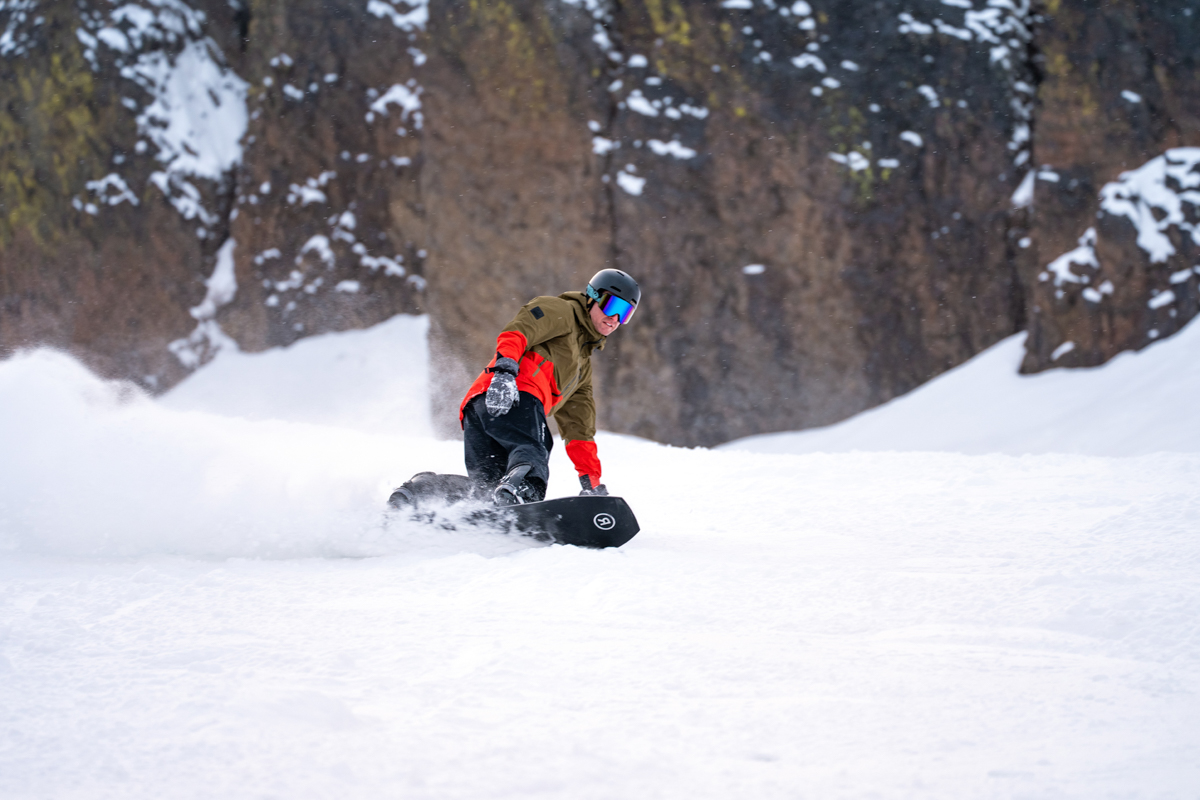
Many of the boards above come in women’s-specific versions, which are generally softer-flexing and available in smaller sizes, and usually feature different design aesthetics (we've link to both above when available). However, some companies have begun taking a more wholistic approach to their lineups, doing away with gendered boards and instead offering unisex models in various sizes and flexes. When looking at the list above, we invite you to shop based less on your gender and more on what you know about yourself as a rider, including your body type, riding style, and desired board experience. And if a certain model appeals to you, it's often the case that the company makes a similar board with a slightly softer or stiffer flex. Finally, it's worth noting that there are a few female-specific snowboard manufacturers, including Coalition and Pallas.
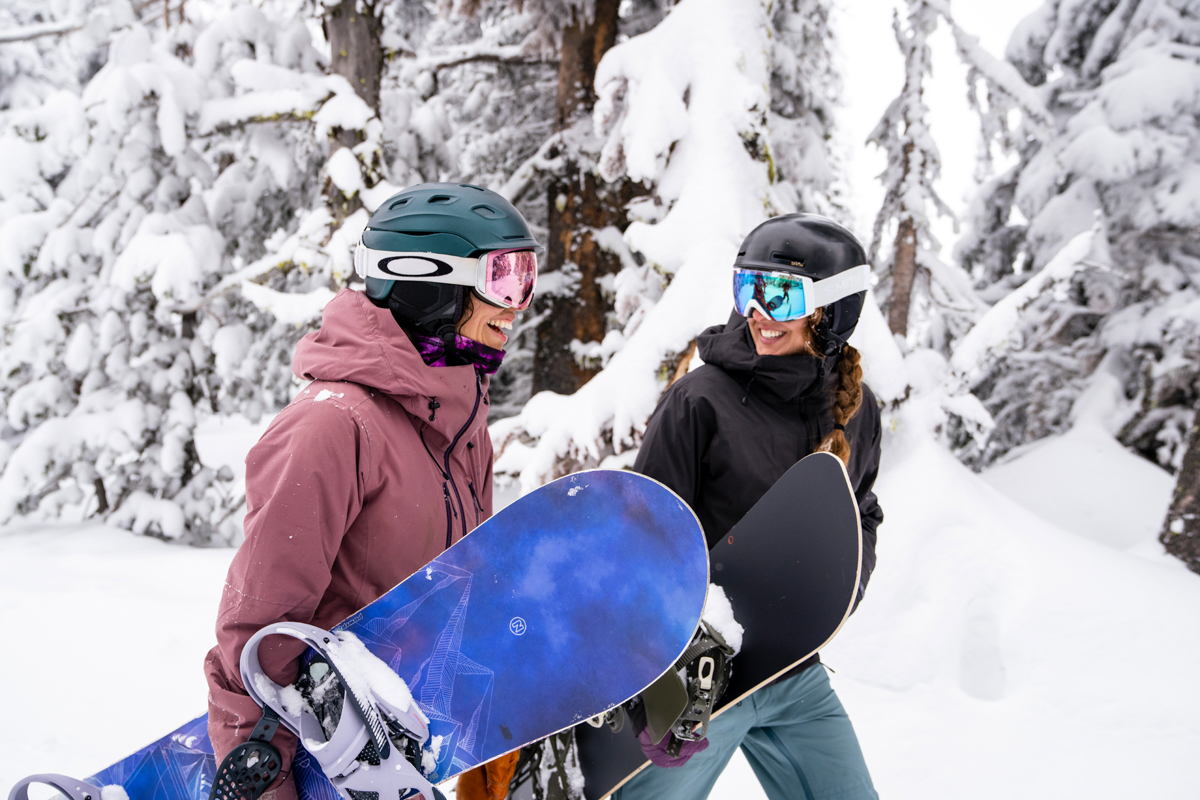
A board might be the biggest part of your snowboarding setup, but it’s only one piece of the puzzle. Boots and bindings are equally important and should align with your style of riding and your board’s level of support. Starting with boots, the most crucial factor is stiffness, which is indicated by a flex rating. In general, a stiffer boot will offer better stability and is best suited to more aggressive all-mountain freeride and all-mountain boards. Alternatively, a softer boot will allow more flex and forgiveness, which can be helpful in pressing jibs and tweaking grabs on a park or softer all-mountain/freestyle board. A softer flex will also be more comfortable for beginners and require less break-in time. Boot flex ratings aren’t entirely standardized and can vary from brand to brand, but many manufacturers will rate a boot’s stiffness on a scale of 1-10 (soft to stiff).
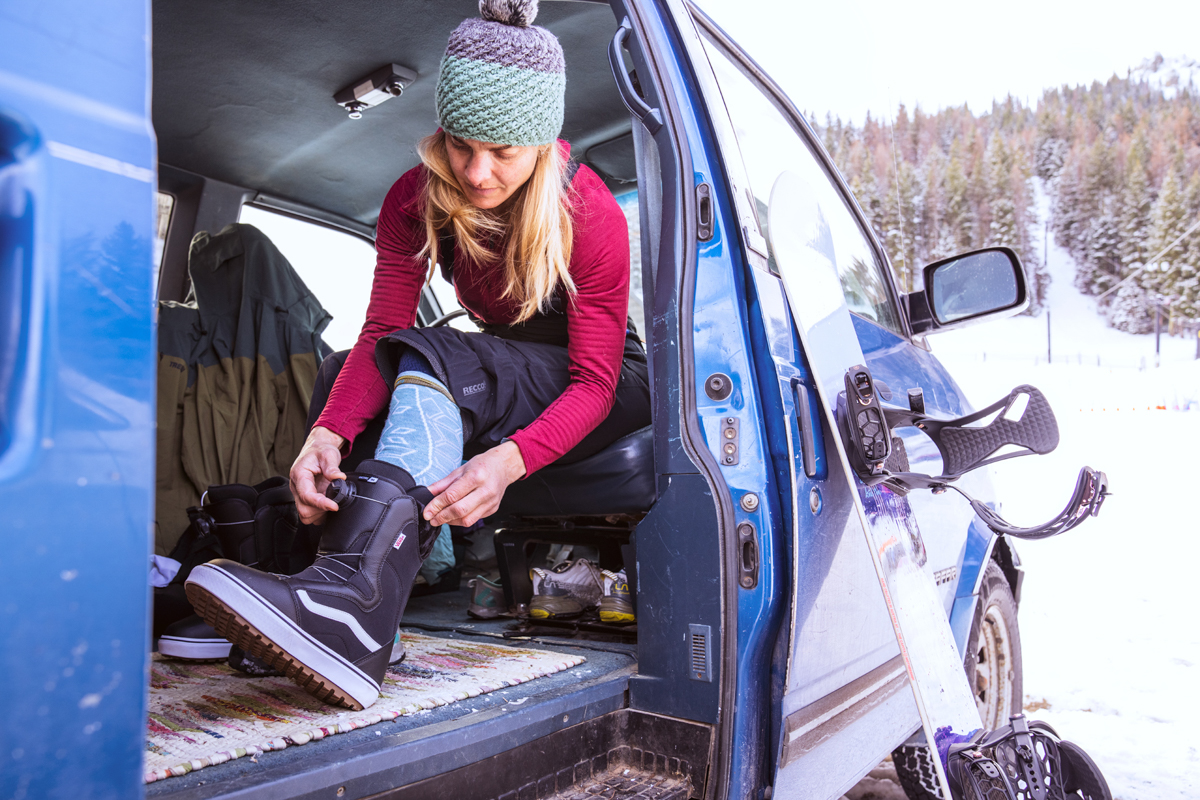
Snowboard bindings are similar to boots in that they vary from soft to stiff (again, usually on a scale of 1-10) and should match your overall riding style and preferences. Like boots and boards, softer bindings allow more flex for beginners and park goers while stiff bindings are more responsive and stable. Finally, it’s important to make sure that your bindings match the connection on your board, whether it’s 4x4 bolts, 2x4 bolts, or a system like Burton’s EST sliders. If you need assistance determining the right type of binding to match your board, we recommend reaching out to your local snowsports shop (we've assembled our favorite online retailers here).
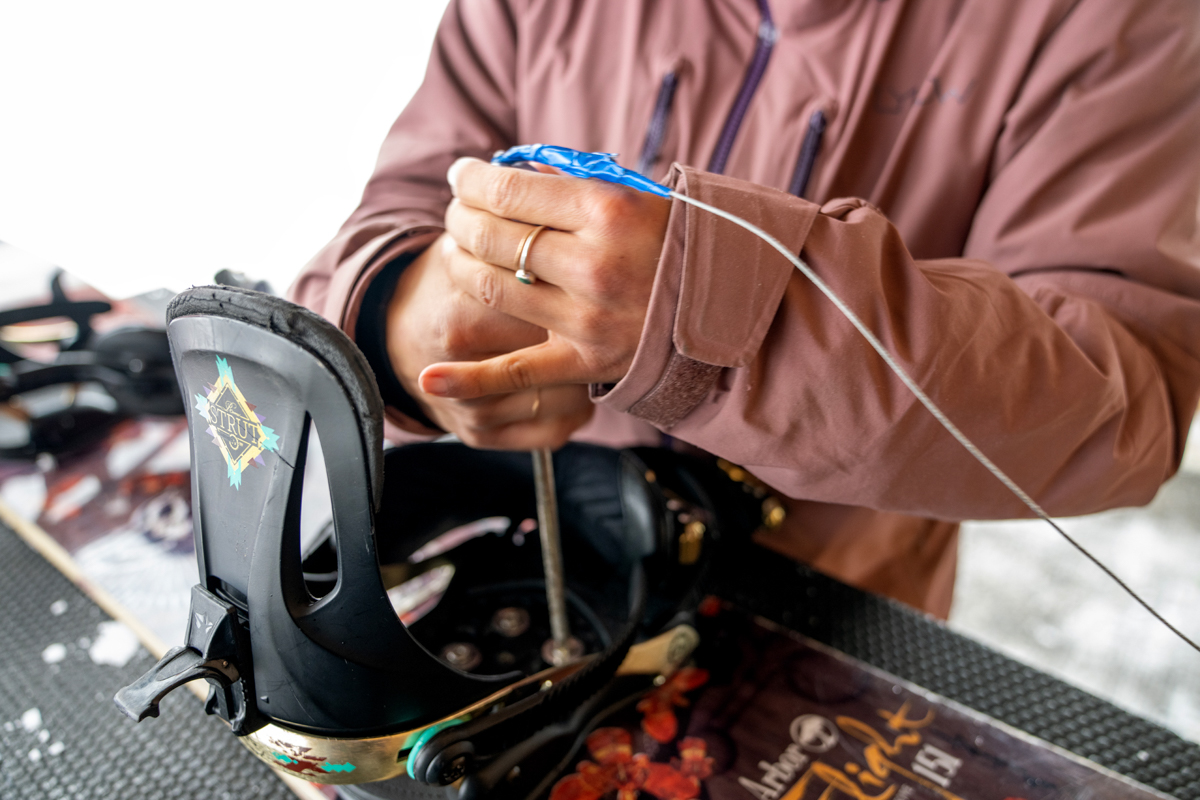
The boards above are built for resort terrain, but for those who like to explore out of bounds, a splitboard makes a lot of sense. These backcountry-specific designs are essentially a snowboard that’s cut in half from nose to tail with edges along the cut. On the uphill, you climb with the two pieces separated, and you reconnect them for the descent. Specialty bindings also are required, which are able to switch from a parallel setup with a free heel for touring to a perpendicular orientation for locking in on the downhill.
.jpg)
What do you compromise by going with a splitboard? First and foremost, they’re significantly more expensive than traditional downhill offerings—it’s a good idea to make sure you want to put in the uphill work before taking the plunge. In addition, the split nature of the construction impacts their performance and natural feel and flex, making them not all that versatile for lapping the resort (you certainly won’t want to use one as your quiver-of-one setup). And most importantly, before you get excited about the gear, we recommend taking an AIARE Level 1 course or equivalent to learn how to properly and safely travel in the backcountry.
Back to Our Top All-Mountain Snowboard Picks Back to Our Snowboard Comparison Table